Moira Butterfield's Blog, page 39
April 22, 2018
Having Fun Making Stuff Up • Lynne Garner
At the end of last year I was lucky enough to attend a writers retreat at Folly Farm Centre. It's an annual event run for and by members of the Scattered Authors Society. It's located between Bath and Bristol and is a restored 18th century farmhouse, which is nestled in 250 acres of nature reserve with wildflower meadows and ancient woodlands.
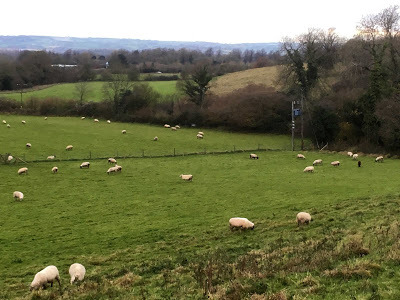 View from my roomThere is time allocated for writing, walking, socialising, eating and drinking. However, those who are attending also have the opportunity to share their knowledge. As the sessions are run by those attending they change every year. One of the sessions I attended this time was run by the fab Alex English. It was meant as a bit of fun but also to demonstrate that ideas don't have to be difficult to find.
View from my roomThere is time allocated for writing, walking, socialising, eating and drinking. However, those who are attending also have the opportunity to share their knowledge. As the sessions are run by those attending they change every year. One of the sessions I attended this time was run by the fab Alex English. It was meant as a bit of fun but also to demonstrate that ideas don't have to be difficult to find.
Once we'd got over the shock that we'd be drawing I think it was fair to say all those who attended really enjoyed the session. So, what was this session?
Firstly, we were asked to fold a piece of A4 into 16 equal rectangles. We were then given a very limited time to write a name or character type in the top of the first box. The piece of paper was passed onto the next person who wrote a name or character type in the next box. This continued until each box had a name or character type.
Then the drawing bit!
We were given slightly longer to quickly sketch in the first box based on the name/character type at the top of that box, pass on to the next person who repeated the process. Until all 16 boxes were filled.
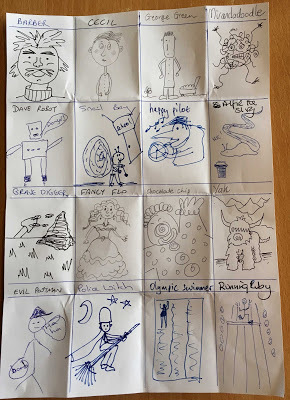 Steps one and twoThe next step was to take a second piece of A4 paper and fold into four sections and choose one the the characters on the piece of paper we had in front of us. I chose Yak - he just 'spoke' to me. We were told to place our chosen character in the top left hand corner rectangle and create a scenario. The piece of paper was passed to someone else in the room (we could not be sitting next to one another) and that person had to create the second scene. This was repeated another two times, with the last person having to create the ending to our very short story.
Steps one and twoThe next step was to take a second piece of A4 paper and fold into four sections and choose one the the characters on the piece of paper we had in front of us. I chose Yak - he just 'spoke' to me. We were told to place our chosen character in the top left hand corner rectangle and create a scenario. The piece of paper was passed to someone else in the room (we could not be sitting next to one another) and that person had to create the second scene. This was repeated another two times, with the last person having to create the ending to our very short story.
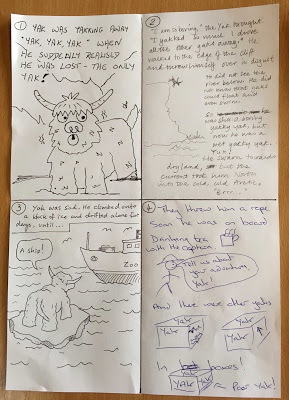 I still 'love' Yak, so may use him in a future story
I still 'love' Yak, so may use him in a future story
As you can see it's an easy idea and generated a lot of fun and different characters. So, why not give it a go and see what you come up with.
Regards
Lynne
Recent books include: Anansi the Trickster Spider, Ten Tales of Brer Rabbit, Ten Tales of Coyote and Hedgehog of Moon Meadow Farm
 View from my roomThere is time allocated for writing, walking, socialising, eating and drinking. However, those who are attending also have the opportunity to share their knowledge. As the sessions are run by those attending they change every year. One of the sessions I attended this time was run by the fab Alex English. It was meant as a bit of fun but also to demonstrate that ideas don't have to be difficult to find.
View from my roomThere is time allocated for writing, walking, socialising, eating and drinking. However, those who are attending also have the opportunity to share their knowledge. As the sessions are run by those attending they change every year. One of the sessions I attended this time was run by the fab Alex English. It was meant as a bit of fun but also to demonstrate that ideas don't have to be difficult to find.Once we'd got over the shock that we'd be drawing I think it was fair to say all those who attended really enjoyed the session. So, what was this session?
Firstly, we were asked to fold a piece of A4 into 16 equal rectangles. We were then given a very limited time to write a name or character type in the top of the first box. The piece of paper was passed onto the next person who wrote a name or character type in the next box. This continued until each box had a name or character type.
Then the drawing bit!
We were given slightly longer to quickly sketch in the first box based on the name/character type at the top of that box, pass on to the next person who repeated the process. Until all 16 boxes were filled.
 Steps one and twoThe next step was to take a second piece of A4 paper and fold into four sections and choose one the the characters on the piece of paper we had in front of us. I chose Yak - he just 'spoke' to me. We were told to place our chosen character in the top left hand corner rectangle and create a scenario. The piece of paper was passed to someone else in the room (we could not be sitting next to one another) and that person had to create the second scene. This was repeated another two times, with the last person having to create the ending to our very short story.
Steps one and twoThe next step was to take a second piece of A4 paper and fold into four sections and choose one the the characters on the piece of paper we had in front of us. I chose Yak - he just 'spoke' to me. We were told to place our chosen character in the top left hand corner rectangle and create a scenario. The piece of paper was passed to someone else in the room (we could not be sitting next to one another) and that person had to create the second scene. This was repeated another two times, with the last person having to create the ending to our very short story. I still 'love' Yak, so may use him in a future story
I still 'love' Yak, so may use him in a future story As you can see it's an easy idea and generated a lot of fun and different characters. So, why not give it a go and see what you come up with.
Regards
Lynne
Recent books include: Anansi the Trickster Spider, Ten Tales of Brer Rabbit, Ten Tales of Coyote and Hedgehog of Moon Meadow Farm
Published on April 22, 2018 22:30
April 15, 2018
How to Help Children Deal with Fear - Chitra Soundar
While fear isn’t always a bad thing and it stops us from doing things that might harm us – like touching flames or approaching a tiger, all children as they understand the world around them go through fears.
Telling a child (or an adult) not to fear something is not going to fix the problem. But maintaining calm when a child is fearful, telling stories, singing to them will reduce the current and future anxiety associated with that specific fear.
In her articleon WebMD, Annie Stuart points out that storms, sudden and loud noises are common childhood fears. And that is reiterated by this research that surveyed 1700 kids.
Dr Lagattuta quoted in the same article says that it takes the age of seven at least for children to be able to redirect their attention to something less fearful, to take their mind off things. So until then what children need is a deliberate redirection of their thoughts by adults and in my world that is storytelling.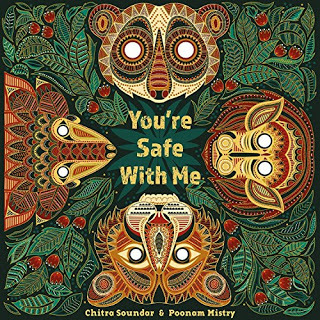 In my latest book You’re SafeWith Me, little animals are afraid of the thunderstorm and its elements – wind, thunder, lightning, the river and darkness. The little animals are reassured by Mama Elephant calmly as she repeats “You’re Safe With Me” and at the same time, she distracts their thoughts into a happy place – she tells them why these elements are loud and how they are fascinating in their own way. The wind brings seeds from faraway places to make the forest, the lightning breaks into small stars.
In my latest book You’re SafeWith Me, little animals are afraid of the thunderstorm and its elements – wind, thunder, lightning, the river and darkness. The little animals are reassured by Mama Elephant calmly as she repeats “You’re Safe With Me” and at the same time, she distracts their thoughts into a happy place – she tells them why these elements are loud and how they are fascinating in their own way. The wind brings seeds from faraway places to make the forest, the lightning breaks into small stars.
That’s why the refrain in this story is important – it doesn’t reject the fears of the little animals. Mama Elephant acknowledges their fear and tries to deflect their worries into happy thoughts. That’s exactly what Pam Nicholson, a certified parenting educator says in her article here. Lori Lite, a certified children's meditation facilitator quoted in this article says – to reassure young children and to reduce their worries, there is one simple technique – turn on a CD or a read a book. Dr. Michele Borba too in her websiterecommends reading books about fears – bibliotherapy as professionals call it, will help deal with the worries. Many of us in the book world know that books are a great way to address fears, have discussions with children about their worries. So I thought I'd list some books that deal with worries, fears and emotions that can be used when reassuring or distracting children from their fears. Find a list of books that deal with fears, emotions of one’s own and others in this wonderful curated list at Empathy Lab - http://www.empathylab.uk/empathybookcollection And here is a long list of books (from US predominantly) that deal with fears and worries. https://centerforparentingeducation.org/recommended-parenting-books/recommended-childrens-books/#fears And finally here is a list of helpful articles on handling children’s fears that you might want to read: https://www.anxietybc.com/sites/default/files/TalkingtoYourChildabout.pdfhttp://kidshealth.org/en/kids/comments-scared.htmlhttps://centerforparentingeducation.org/library-of-articles/healthy-communication/haunted-houses-childrens-fears/http://micheleborba.com/10-tools-to-help-kids-manage-fear/
 Chitra Soundar is the author of over 30 books for children. Find out more about You’re Safe With Me and all her new books at www.chitrasoundar.com and follow her on twitter @csoundar
Chitra Soundar is the author of over 30 books for children. Find out more about You’re Safe With Me and all her new books at www.chitrasoundar.com and follow her on twitter @csoundar
Telling a child (or an adult) not to fear something is not going to fix the problem. But maintaining calm when a child is fearful, telling stories, singing to them will reduce the current and future anxiety associated with that specific fear.
In her articleon WebMD, Annie Stuart points out that storms, sudden and loud noises are common childhood fears. And that is reiterated by this research that surveyed 1700 kids.
Dr Lagattuta quoted in the same article says that it takes the age of seven at least for children to be able to redirect their attention to something less fearful, to take their mind off things. So until then what children need is a deliberate redirection of their thoughts by adults and in my world that is storytelling.
 In my latest book You’re SafeWith Me, little animals are afraid of the thunderstorm and its elements – wind, thunder, lightning, the river and darkness. The little animals are reassured by Mama Elephant calmly as she repeats “You’re Safe With Me” and at the same time, she distracts their thoughts into a happy place – she tells them why these elements are loud and how they are fascinating in their own way. The wind brings seeds from faraway places to make the forest, the lightning breaks into small stars.
In my latest book You’re SafeWith Me, little animals are afraid of the thunderstorm and its elements – wind, thunder, lightning, the river and darkness. The little animals are reassured by Mama Elephant calmly as she repeats “You’re Safe With Me” and at the same time, she distracts their thoughts into a happy place – she tells them why these elements are loud and how they are fascinating in their own way. The wind brings seeds from faraway places to make the forest, the lightning breaks into small stars. That’s why the refrain in this story is important – it doesn’t reject the fears of the little animals. Mama Elephant acknowledges their fear and tries to deflect their worries into happy thoughts. That’s exactly what Pam Nicholson, a certified parenting educator says in her article here. Lori Lite, a certified children's meditation facilitator quoted in this article says – to reassure young children and to reduce their worries, there is one simple technique – turn on a CD or a read a book. Dr. Michele Borba too in her websiterecommends reading books about fears – bibliotherapy as professionals call it, will help deal with the worries. Many of us in the book world know that books are a great way to address fears, have discussions with children about their worries. So I thought I'd list some books that deal with worries, fears and emotions that can be used when reassuring or distracting children from their fears. Find a list of books that deal with fears, emotions of one’s own and others in this wonderful curated list at Empathy Lab - http://www.empathylab.uk/empathybookcollection And here is a long list of books (from US predominantly) that deal with fears and worries. https://centerforparentingeducation.org/recommended-parenting-books/recommended-childrens-books/#fears And finally here is a list of helpful articles on handling children’s fears that you might want to read: https://www.anxietybc.com/sites/default/files/TalkingtoYourChildabout.pdfhttp://kidshealth.org/en/kids/comments-scared.htmlhttps://centerforparentingeducation.org/library-of-articles/healthy-communication/haunted-houses-childrens-fears/http://micheleborba.com/10-tools-to-help-kids-manage-fear/
 Chitra Soundar is the author of over 30 books for children. Find out more about You’re Safe With Me and all her new books at www.chitrasoundar.com and follow her on twitter @csoundar
Chitra Soundar is the author of over 30 books for children. Find out more about You’re Safe With Me and all her new books at www.chitrasoundar.com and follow her on twitter @csoundar
Published on April 15, 2018 23:00
April 8, 2018
The Last Wolf & Other Missing Animals • Mini Grey
HALF OUR ANIMALS ARE MISSING!
 Missing Animals: from Mini's intermittent blog, Sketching Weakly.
Missing Animals: from Mini's intermittent blog, Sketching Weakly.A few years ago an announcement came out in the news. According to the WWF Living Planet report, since the 1970s more than half of the wild vertebrate animals on Earth had quietly disappeared. Half of our animals are missing! – how could we have been so careless? And those were the big, visible animals. In a more recent study from Germany, 75% of flying insects - the insects on which everything else depends - were found to have vanished in 25 years. Things are quietly disappearing – why are they disappearing?
THE LAST WOLF IN ENGLAND
The story of The Last Wolf started with Red Riding Hood. I wondered: what if, instead of taking that basket of goodies to Granny, Red is in the woods because she wants to catch a wolf. But could she actually find a wolf? In England, wolves were probably extinct by 1500, and the last wolf in Scotland may have been killed in 1680. There were once wolves, lynxes and bears, but we’ve lost all our big predators now and become a land of more Wind in the Willows-sized animals. But walking in the woods can make you remember that the woods could once be dangerous places, where the unwary and unwise could get into trouble. It’s easy to be hidden in woods.
 Wytham Woods
Wytham Woods Near where I live in Oxford are the wonderful Wytham Woods, which have been studied for over 60 years and where you can walk around and see big old trees full of lumps and crevices, which are also fun to draw. When I was thinking about the story of The Last Wolf I liked walking in Wytham Woods and imagining a wolf was there, and drawing the big old trees.
 Big old tree at Lytham Woods
Big old tree at Lytham WoodsI collected my favourite picture book trees – which started with this illustration by Jenny Williams and below, from John Masefield’s The Midnight Folk illustrated by Sara Ogilvy.
 Jenny Williams
Jenny Williams
 John Masefield’s The Midnight Folk by Sara Ogilvy
John Masefield’s The Midnight Folk by Sara Ogilvy Pinocchio by Michael Morpurgo, illustrated by Emma Chichester ClarkeThese wonderful wolfish woods are from Emma Chichester Clarke and Michael Morpurgo’s Pinocchio. I kept these at hand for inspiration. Most of my previous picture books have been set indoors in the world of man-made things, so it was exciting to go venturing into the trees. Here are some sketchbook pages from when I was working out The Last Wolf. I wasn’t sure how to end the story. I did want to begin and end the story with the Good Old Days forest at the beginning and the shrunken woods eaten into by houses at the end, but my wise editor Joe Marriott at Penguin Random House helped me to find a more hopeful ending.
Pinocchio by Michael Morpurgo, illustrated by Emma Chichester ClarkeThese wonderful wolfish woods are from Emma Chichester Clarke and Michael Morpurgo’s Pinocchio. I kept these at hand for inspiration. Most of my previous picture books have been set indoors in the world of man-made things, so it was exciting to go venturing into the trees. Here are some sketchbook pages from when I was working out The Last Wolf. I wasn’t sure how to end the story. I did want to begin and end the story with the Good Old Days forest at the beginning and the shrunken woods eaten into by houses at the end, but my wise editor Joe Marriott at Penguin Random House helped me to find a more hopeful ending.

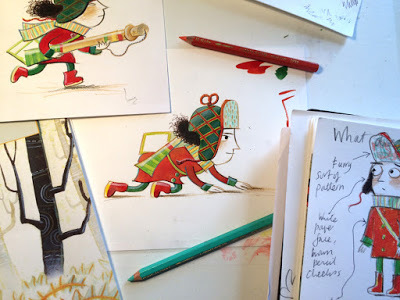
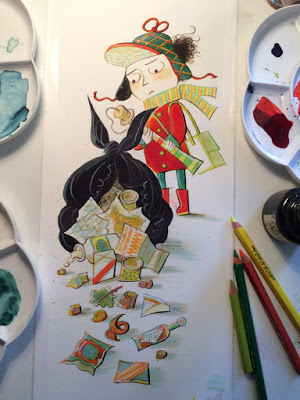 Sketch book pages. Mini Grey
Sketch book pages. Mini GreyHere’s the bit in the book where Red meets the Last Wolf.


And now to….VAUCANSON’S DUCK This is all that was last seen of Vaucanson’s Duck.
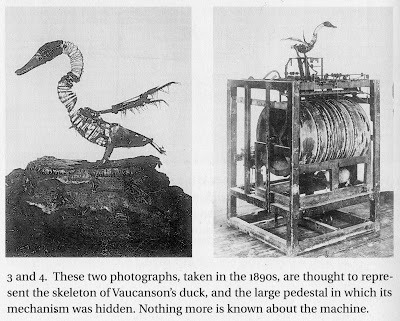
It is thought to have been destroyed in a fire in 1879. The Duck was an extraordinarily life like automaton. It could quack and drink and eat duck-food, which it would then transform into duck-poo to the astonishment of everybody around. It looked like a living breathing bird. But the burnt remains of the Duck reveal the cogs and springs and cams which made this illusion of life happen.
ANIMALS AND USIn the usual human view of the world, it is divided into those that talk and those that don’t. This is very useful, because it means that those that talk can farm and eat those that don’t.
 Rene Descartes
Rene DescartesIt is Rene Descartes I blame for this. Descartes (1596 - 1650) maintained that animals cannot reason and do not feel pain; animals are living organic creatures, but they are automata, like mechanical robots. Descartes held that only humans are conscious, have minds and souls, can learn and have language and therefore only humans are deserving of compassion. He assumed animals were automata. But this is a big mix-up: automata – machines which create an illusion of inner life, but work by clockwork and cams - can only be made by humans. Only people make machines like this. Nature doesn’t work this way. In the animal world it seems feelings drive behaviour. Feelings give the impulse to act, and determine what that action might be. Feeling scared at a threat brings an impulse to run away. Feeling strong, brave or angry will make you act differently. If something behaves like it has an inner life – then, I argue – it probably does. If my dog behaves like it is scared, it is because it feels scared. If my dog is behaving like it is pleased to see me, then it must be because it feels pleased to see me (I hope!) Rene Descartes drew up the drawbridge, made the world into Us and Them, human and non-human. The non-human can’t talk, so doesn’t have an inner life. And that means they can be owned, eaten and treated as slaves – all very economically useful. Only with the ideas of Charles Darwin did we start to see ourselves in the continuum of the tree of life, and take our place in the unfolding story of evolution.
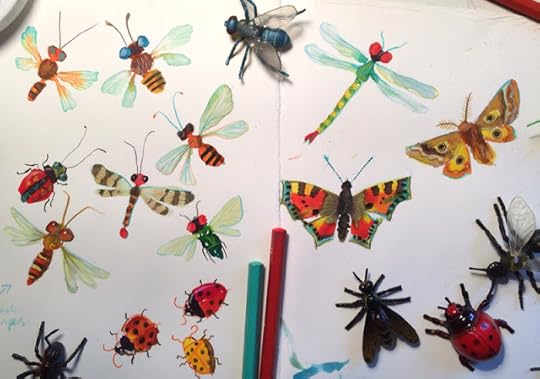
Picture books are a fantastic direct line to empathy and imagination–– where else can you explore what it would feel like to be an egg or a biscuit or a spoon?
 But also the great thing about picture books is they are an arena where you can make anything you want happen. And one thing I’ve always wanted is to meet is an animal that could talk. But talking animals only really happen in books. The world of children’s books is crammed with talking animals – from Alice in Wonderland to Narnia to Philip Pullman’s daemons to Piers Torday’s Last Wild – talking animals are rife. Books are windows and doors into experiencing being someone else and that someone may be an animal.
But also the great thing about picture books is they are an arena where you can make anything you want happen. And one thing I’ve always wanted is to meet is an animal that could talk. But talking animals only really happen in books. The world of children’s books is crammed with talking animals – from Alice in Wonderland to Narnia to Philip Pullman’s daemons to Piers Torday’s Last Wild – talking animals are rife. Books are windows and doors into experiencing being someone else and that someone may be an animal.
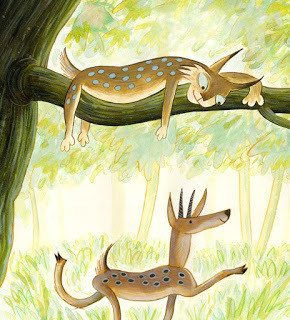
The legacy of Rene Descartes was to see animals as automata, giving an illusion of inner life, but not really having it. But automata are only possible because they are manmade – nothing in nature works this way. The inner lives of animals are worth imagining, what it must feel like to be them. Some animals end up being food. Would we be able to treat talking animals this way? It would seem a bit rude to eat someone who you could have a conversation with (see the Dish of the Day episode in Hitchhiker’s Guide to the Galaxy.) But maybe it is even ruder to eat someone you don’t know at all. An anonymous meat could well have had a terrible life. Maybe it is worth asking the question: Meat - Who did it use to be?Packaging is powerful stuff. It would be useful if meat packets could tell us more about the life of whoever is in the packet, so we could choose the one who had a good life before they were meat.
 Meat: Who did it used to be? From Sketching Weakly
Meat: Who did it used to be? From Sketching WeaklyMORE TREES PLEASE

Red Riding Hood is a tale that came out of the terror of the forests – the ancient human struggle for survival against nature and predators. But things aren’t like this anymore – we’ve remade the landscape of our planet and its animals to support nearly 7 billion humans on Earth. It could be time now to change our Us and Them thinking. It always used to have to be ‘Humans first’, because we were small and the Wild was vast. But now the vast majority – some say 98% - of the mass of vertebrate land animals is us and our livestock. Could we give back a bit more space for the Rest of the World? We could include thinking about nature in everything we plan, and try putting a real value on our existing nature especially ancient woodlands. The amazing 4.6 billion year story of life on Earth – the complex long weaving of our life on Earth - is it OK to unravel and simplify this?
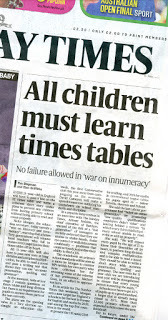 A Sunday Times headline: as it was...
A Sunday Times headline: as it was...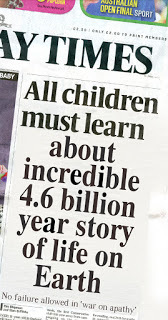 and as it could be.
and as it could be.We can tackle this by framing everything we do in the context of nature, but also we have to step back a bit – leave more land unclaimed, leave the Antarctic Krill for the Antarctic animals. This needs regulation and legislation, otherwise a tragedy of the commons always happens. The National Planning Policy Statement of 2012 put ‘sustainable development’ (is that not an impossible thing?) at the heart of the planning system.
Here’s my dictionaries definition of ‘sustainable’:
Sustainable adj 1 able to be sustained. 2 able to be maintained at a fixed level without exhausting natural resources or damaging the environment: sustainable development.
So – sustainable development means development at a level which can be continued indefinitely without environmental degradation. If you systematically convert unbuilt-on land into built-on land so the overall balance of land-use changes – this is not sustainable if carried on indefinitely even at a low level.There’s a new draft National Planning Policy Statement out for consultation right now. We should make sure that putting space for Nature is at the heart of everything we plan.Here’s how you can give feedback

Trees are multi-level, they make habitats more three dimensional. Trees seem especially important in cities. The challenge is: can we create our buildings in sympathy with trees, plan around big trees, be generous and build with enough space for big trees? Can we value big old trees as special individual entities – to be valued like national treasures, like St Paul’s Cathedral? A big old tree gives vastly more to us than a young sapling. They are not interchangeable. We have to factor in time, put a value on time so it is not affordable to cut down a big tree. It seems that Sheffield City Council’s destruction of their street trees at the moment is demonstrating exactly how not to do things.
 Winter trees in Grosvenor Square, London. Mini Grey
Winter trees in Grosvenor Square, London. Mini Grey Plane trees in Grosvenor Square, London. Mini Grey
Plane trees in Grosvenor Square, London. Mini Grey Chestnut tree near Iffley Lock, Oxford. Mini GreyMAKING SPACE FOR NATUREIf you give animals space and habitat to live in they bounce back. Rewilding Yellowstone Park with wolves boosted the whole dimensions of biodiversity there, by returning a missing keystone species – changing the behaviour of their prey and enabling woodland to grow back. Pine martins, red kites, beavers are all coming back from the brink in the UK. Rewilding can make more for all of us by restoring a balance of predators and prey and a more complex natural world. Every little bit of wilderness helps.
Chestnut tree near Iffley Lock, Oxford. Mini GreyMAKING SPACE FOR NATUREIf you give animals space and habitat to live in they bounce back. Rewilding Yellowstone Park with wolves boosted the whole dimensions of biodiversity there, by returning a missing keystone species – changing the behaviour of their prey and enabling woodland to grow back. Pine martins, red kites, beavers are all coming back from the brink in the UK. Rewilding can make more for all of us by restoring a balance of predators and prey and a more complex natural world. Every little bit of wilderness helps.
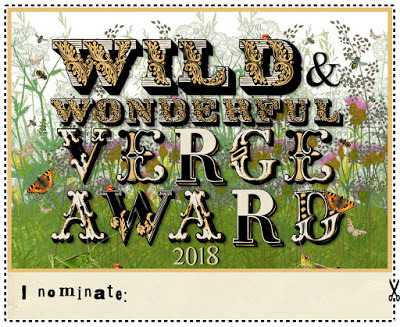
Here’s a useful cut-out-and-keep Wild Verges Award– if you see a particularly lovely roadside verge of cow parsley and wild flowers later in the year you could award it to the council concerned. Or give it to your own garden.
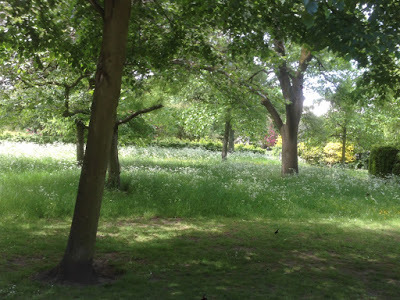 A nice bit of cow parsley in Regent's Park, London.
A nice bit of cow parsley in Regent's Park, London.Mini Grey is the author and illustrator of "The Bad Bunnies Magic Show", "Biscuit Bear", "Hermelin", "Three By The Sea" and the inimitable "Traction Man" amongst others. Mini lives in Oxford with her family and cat Bonzetta.
"The Last Wolf" is out now from Jonathan Cape
See more of Mini's work on her website here and Mini's blog Sketching Weakly.
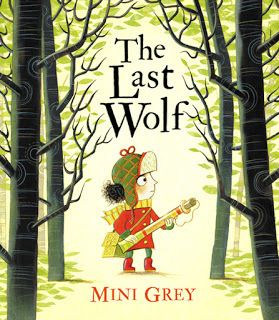
Published on April 08, 2018 15:55
The Last Wolf & Other Missing AnimalsMini GreyHALF OU...
The Last Wolf & Other Missing Animals
Mini Grey
HALF OUR ANIMALS ARE MISSING! Missing Animals: from Mini's intermittent blog, Sketching Weakly.
Missing Animals: from Mini's intermittent blog, Sketching Weakly.
A few years ago an announcement came out in the news. According to the WWF Living Planet report, since the 1970s more than half of the wild vertebrate animals on Earth had quietly disappeared. Half of our animals are missing! – how could we have been so careless? And those were the big, visible animals. In a more recent study from Germany, 75% of flying insects - the insects on which everything else depends - were found to have vanished in 25 years. Things are quietly disappearing – why are they disappearing?
THE LAST WOLF IN ENGLAND
The story of The Last Wolf started with Red Riding Hood. I wondered: what if, instead of taking that basket of goodies to Granny, Red is in the woods because she wants to catch a wolf. But could she actually find a wolf? In England, wolves were probably extinct by 1500, and the last wolf in Scotland may have been killed in 1680. There were once wolves, lynxes and bears, but we’ve lost all our big predators now and become a land of more Wind in the Willows-sized animals. But walking in the woods can make you remember that the woods could once be dangerous places, where the unwary and unwise could get into trouble. It’s easy to be hidden in woods.
 Wytham Woods
Wytham Woods
Near where I live in Oxford are the wonderful Wytham Woods, which have been studied for over 60 years and where you can walk around and see big old trees full of lumps and crevices, which are also fun to draw. When I was thinking about the story of The Last Wolf I liked walking in Wytham Woods and imagining a wolf was there, and drawing the big old trees. Big old tree at Lytham Woods
Big old tree at Lytham Woods
I collected my favourite picture book trees – which started with this illustration by Jenny Williams and below, from John Masefield’s The Midnight Folk illustrated by Sara Ogilvy.
 Jenny Williams
Jenny Williams
 John Masefield’s The Midnight Folk by Sara Ogilvy
John Masefield’s The Midnight Folk by Sara Ogilvy
 Pinocchio by Michael Morpurgo, illustrated by Emma Chichester ClarkeThese wonderful wolfish woods are from Emma Chichester Clarke and Michael Morpurgo’s Pinocchio. I kept these at hand for inspiration. Most of my previous picture books have been set indoors in the world of man-made things, so it was exciting to go venturing into the trees. Here are some sketchbook pages from when I was working out The Last Wolf. I wasn’t sure how to end the story. I did want to begin and end the story with the Good Old Days forest at the beginning and the shrunken woods eaten into by houses at the end, but my wise editor Joe Marriott at Penguin Random House helped me to find a more hopeful ending.
Pinocchio by Michael Morpurgo, illustrated by Emma Chichester ClarkeThese wonderful wolfish woods are from Emma Chichester Clarke and Michael Morpurgo’s Pinocchio. I kept these at hand for inspiration. Most of my previous picture books have been set indoors in the world of man-made things, so it was exciting to go venturing into the trees. Here are some sketchbook pages from when I was working out The Last Wolf. I wasn’t sure how to end the story. I did want to begin and end the story with the Good Old Days forest at the beginning and the shrunken woods eaten into by houses at the end, but my wise editor Joe Marriott at Penguin Random House helped me to find a more hopeful ending.


 Sketch book pages. Mini Grey
Sketch book pages. Mini Grey
Here’s the bit in the book where Red meets the Last Wolf.

And now to….VAUCANSON’S DUCK This is all that was last seen of Vaucanson’s Duck.
It is thought to have been destroyed in a fire in 1879. The Duck was an extraordinarily life like automaton. It could quack and drink and eat duck-food, which it would then transform into duck-poo to the astonishment of everybody around. It looked like a living breathing bird. But the burnt remains of the Duck reveal the cogs and springs and cams which made this illusion of life happen.
ANIMALS AND USIn the usual human view of the world, it is divided into those that talk and those that don’t. This is very useful, because it means that those that talk can farm and eat those that don’t. Rene Descartes
Rene Descartes
It is Rene Descartes I blame for this. Descartes (1596 - 1650) maintained that animals cannot reason and do not feel pain; animals are living organic creatures, but they are automata, like mechanical robots. Descartes held that only humans are conscious, have minds and souls, can learn and have language and therefore only humans are deserving of compassion. He assumed animals were automata. But this is a big mix-up: automata – machines which create an illusion of inner life, but work by clockwork and cams - can only be made by humans. Only people make machines like this. Nature doesn’t work this way. In the animal world it seems feelings drive behaviour. Feelings give the impulse to act, and determine what that action might be. Feeling scared at a threat brings an impulse to run away. Feeling strong, brave or angry will make you act differently. If something behaves like it has an inner life – then, I argue – it probably does. If my dog behaves like it is scared, it is because it feels scared. If my dog is behaving like it is pleased to see me, then it must be because it feels pleased to see me (I hope!) Rene Descartes drew up the drawbridge, made the world into Us and Them, human and non-human. The non-human can’t talk, so doesn’t have an inner life. And that means they can be owned, eaten and treated as slaves – all very economically useful. Only with the ideas of Charles Darwin did we start to see ourselves in the continuum of the tree of life, and take our place in the unfolding story of evolution.
Picture books are a fantastic direct line to empathy and imagination–– where else can you explore what it would feel like to be an egg or a biscuit or a spoon? But also the great thing about picture books is they are an arena where you can make anything you want happen. And one thing I’ve always wanted is to meet is an animal that could talk. But talking animals only really happen in books. The world of children’s books is crammed with talking animals – from Alice in Wonderland to Narnia to Philip Pullman’s daemons to Piers Torday’s Last Wild – talking animals are rife. Books are windows and doors into experiencing being someone else and that someone may be an animal.
But also the great thing about picture books is they are an arena where you can make anything you want happen. And one thing I’ve always wanted is to meet is an animal that could talk. But talking animals only really happen in books. The world of children’s books is crammed with talking animals – from Alice in Wonderland to Narnia to Philip Pullman’s daemons to Piers Torday’s Last Wild – talking animals are rife. Books are windows and doors into experiencing being someone else and that someone may be an animal.

The legacy of Rene Descartes was to see animals as automata, giving an illusion of inner life, but not really having it. But automata are only possible because they are manmade – nothing in nature works this way. The inner lives of animals are worth imagining, what it must feel like to be them. Some animals end up being food. Would we be able to treat talking animals this way? It would seem a bit rude to eat someone who you could have a conversation with (see the Dish of the Day episode in Hitchhiker’s Guide to the Galaxy.) But maybe it is even ruder to eat someone you don’t know at all. An anonymous meat could well have had a terrible life. Maybe it is worth asking the question: Meat - Who did it use to be?Packaging is powerful stuff. It would be useful if meat packets could tell us more about the life of whoever is in the packet, so we could choose the one who had a good life before they were meat. Meat: Who did it used to be? From Sketching Weakly
Meat: Who did it used to be? From Sketching Weakly
MORE TREES PLEASE

Red Riding Hood is a tale that came out of the terror of the forests – the ancient human struggle for survival against nature and predators. But things aren’t like this anymore – we’ve remade the landscape of our planet and its animals to support nearly 7 billion humans on Earth. It could be time now to change our Us and Them thinking. It always used to have to be ‘Humans first’, because we were small and the Wild was vast. But now the vast majority – some say 98% - of the mass of vertebrate land animals is us and our livestock. Could we give back a bit more space for the Rest of the World? We could include thinking about nature in everything we plan, and try putting a real value on our existing nature especially ancient woodlands. The amazing 4.6 billion year story of life on Earth – the complex long weaving of our life on Earth - is it OK to unravel and simplify this?
 A Sunday Times headline: as it was...
A Sunday Times headline: as it was...
 and as it could be.
and as it could be.
We can tackle this by framing everything we do in the context of nature, but also we have to step back a bit – leave more land unclaimed, leave the Antarctic Krill for the Antarctic animals. This needs regulation and legislation, otherwise a tragedy of the commons always happens. The National Planning Policy Statement of 2012 put ‘sustainable development’ (is that not an impossible thing?) at the heart of the planning system.
Here’s my dictionaries definition of ‘sustainable’:
Sustainable adj 1 able to be sustained. 2 able to be maintained at a fixed level without exhausting natural resources or damaging the environment: sustainable development.
So – sustainable development means development at a level which can be continued indefinitely without environmental degradation. If you systematically convert unbuilt-on land into built-on land so the overall balance of land-use changes – this is not sustainable if carried on indefinitely even at a low level.There’s a new draft National Planning Policy Statement out for consultation right now. We should make sure that putting space for Nature is at the heart of everything we plan.Here’s how you can give feedback
Trees are multi-level, they make habitats more three dimensional. Trees seem especially important in cities. The challenge is: can we create our buildings in sympathy with trees, plan around big trees, be generous and build with enough space for big trees? Can we value big old trees as special individual entities – to be valued like national treasures, like St Paul’s Cathedral? A big old tree gives vastly more to us than a young sapling. They are not interchangeable. We have to factor in time, put a value on time so it is not affordable to cut down a big tree. It seems that Sheffield City Council’s destruction of their street trees at the moment is demonstrating exactly how not to do things.
 Winter trees in Grosvenor Square, London. Mini Grey
Winter trees in Grosvenor Square, London. Mini Grey
 Plane trees in Grosvenor Square, London. Mini Grey
Plane trees in Grosvenor Square, London. Mini Grey
 Chestnut tree near Iffley Lock, Oxford. Mini Grey
Chestnut tree near Iffley Lock, Oxford. Mini Grey
MAKING SPACE FOR NATUREIf you give animals space and habitat to live in they bounce back. Rewilding Yellowstone Park with wolves boosted the whole dimensions of biodiversity there, by returning a missing keystone species – changing the behaviour of their prey and enabling woodland to grow back. Pine martins, red kites, beavers are all coming back from the brink in the UK. Rewilding can make more for all of us by restoring a balance of predators and prey and a more complex natural world. Every little bit of wilderness helps.
Here’s a useful cut-out-and-keep Wild Verges Award– if you see a particularly lovely roadside verge of cow parsley and wild flowers later in the year you could award it to the council concerned. Or give it to your own garden. A nice bit of cow parsley in Regent's Park, London.
A nice bit of cow parsley in Regent's Park, London.
Mini Grey is the author and illustrator of "The Bad Bunnies Magic Show", "Biscuit Bear", "Hermelin", "Three By The Sea" and the inimitable "Traction Man" amongst others. Mini lives in Oxford with her family and cat Bonzetta.
"The Last Wolf" is out now from Jonathan Cape
See more of Mini's work on her website here and Mini's blog Sketching Weakly.

Mini Grey
HALF OUR ANIMALS ARE MISSING!
 Missing Animals: from Mini's intermittent blog, Sketching Weakly.
Missing Animals: from Mini's intermittent blog, Sketching Weakly.A few years ago an announcement came out in the news. According to the WWF Living Planet report, since the 1970s more than half of the wild vertebrate animals on Earth had quietly disappeared. Half of our animals are missing! – how could we have been so careless? And those were the big, visible animals. In a more recent study from Germany, 75% of flying insects - the insects on which everything else depends - were found to have vanished in 25 years. Things are quietly disappearing – why are they disappearing?
THE LAST WOLF IN ENGLAND
The story of The Last Wolf started with Red Riding Hood. I wondered: what if, instead of taking that basket of goodies to Granny, Red is in the woods because she wants to catch a wolf. But could she actually find a wolf? In England, wolves were probably extinct by 1500, and the last wolf in Scotland may have been killed in 1680. There were once wolves, lynxes and bears, but we’ve lost all our big predators now and become a land of more Wind in the Willows-sized animals. But walking in the woods can make you remember that the woods could once be dangerous places, where the unwary and unwise could get into trouble. It’s easy to be hidden in woods.
 Wytham Woods
Wytham WoodsNear where I live in Oxford are the wonderful Wytham Woods, which have been studied for over 60 years and where you can walk around and see big old trees full of lumps and crevices, which are also fun to draw. When I was thinking about the story of The Last Wolf I liked walking in Wytham Woods and imagining a wolf was there, and drawing the big old trees.
 Big old tree at Lytham Woods
Big old tree at Lytham WoodsI collected my favourite picture book trees – which started with this illustration by Jenny Williams and below, from John Masefield’s The Midnight Folk illustrated by Sara Ogilvy.
 Jenny Williams
Jenny Williams
 John Masefield’s The Midnight Folk by Sara Ogilvy
John Masefield’s The Midnight Folk by Sara Ogilvy Pinocchio by Michael Morpurgo, illustrated by Emma Chichester ClarkeThese wonderful wolfish woods are from Emma Chichester Clarke and Michael Morpurgo’s Pinocchio. I kept these at hand for inspiration. Most of my previous picture books have been set indoors in the world of man-made things, so it was exciting to go venturing into the trees. Here are some sketchbook pages from when I was working out The Last Wolf. I wasn’t sure how to end the story. I did want to begin and end the story with the Good Old Days forest at the beginning and the shrunken woods eaten into by houses at the end, but my wise editor Joe Marriott at Penguin Random House helped me to find a more hopeful ending.
Pinocchio by Michael Morpurgo, illustrated by Emma Chichester ClarkeThese wonderful wolfish woods are from Emma Chichester Clarke and Michael Morpurgo’s Pinocchio. I kept these at hand for inspiration. Most of my previous picture books have been set indoors in the world of man-made things, so it was exciting to go venturing into the trees. Here are some sketchbook pages from when I was working out The Last Wolf. I wasn’t sure how to end the story. I did want to begin and end the story with the Good Old Days forest at the beginning and the shrunken woods eaten into by houses at the end, but my wise editor Joe Marriott at Penguin Random House helped me to find a more hopeful ending.


 Sketch book pages. Mini Grey
Sketch book pages. Mini GreyHere’s the bit in the book where Red meets the Last Wolf.


And now to….VAUCANSON’S DUCK This is all that was last seen of Vaucanson’s Duck.

It is thought to have been destroyed in a fire in 1879. The Duck was an extraordinarily life like automaton. It could quack and drink and eat duck-food, which it would then transform into duck-poo to the astonishment of everybody around. It looked like a living breathing bird. But the burnt remains of the Duck reveal the cogs and springs and cams which made this illusion of life happen.
ANIMALS AND USIn the usual human view of the world, it is divided into those that talk and those that don’t. This is very useful, because it means that those that talk can farm and eat those that don’t.
 Rene Descartes
Rene DescartesIt is Rene Descartes I blame for this. Descartes (1596 - 1650) maintained that animals cannot reason and do not feel pain; animals are living organic creatures, but they are automata, like mechanical robots. Descartes held that only humans are conscious, have minds and souls, can learn and have language and therefore only humans are deserving of compassion. He assumed animals were automata. But this is a big mix-up: automata – machines which create an illusion of inner life, but work by clockwork and cams - can only be made by humans. Only people make machines like this. Nature doesn’t work this way. In the animal world it seems feelings drive behaviour. Feelings give the impulse to act, and determine what that action might be. Feeling scared at a threat brings an impulse to run away. Feeling strong, brave or angry will make you act differently. If something behaves like it has an inner life – then, I argue – it probably does. If my dog behaves like it is scared, it is because it feels scared. If my dog is behaving like it is pleased to see me, then it must be because it feels pleased to see me (I hope!) Rene Descartes drew up the drawbridge, made the world into Us and Them, human and non-human. The non-human can’t talk, so doesn’t have an inner life. And that means they can be owned, eaten and treated as slaves – all very economically useful. Only with the ideas of Charles Darwin did we start to see ourselves in the continuum of the tree of life, and take our place in the unfolding story of evolution.

Picture books are a fantastic direct line to empathy and imagination–– where else can you explore what it would feel like to be an egg or a biscuit or a spoon?
 But also the great thing about picture books is they are an arena where you can make anything you want happen. And one thing I’ve always wanted is to meet is an animal that could talk. But talking animals only really happen in books. The world of children’s books is crammed with talking animals – from Alice in Wonderland to Narnia to Philip Pullman’s daemons to Piers Torday’s Last Wild – talking animals are rife. Books are windows and doors into experiencing being someone else and that someone may be an animal.
But also the great thing about picture books is they are an arena where you can make anything you want happen. And one thing I’ve always wanted is to meet is an animal that could talk. But talking animals only really happen in books. The world of children’s books is crammed with talking animals – from Alice in Wonderland to Narnia to Philip Pullman’s daemons to Piers Torday’s Last Wild – talking animals are rife. Books are windows and doors into experiencing being someone else and that someone may be an animal.

The legacy of Rene Descartes was to see animals as automata, giving an illusion of inner life, but not really having it. But automata are only possible because they are manmade – nothing in nature works this way. The inner lives of animals are worth imagining, what it must feel like to be them. Some animals end up being food. Would we be able to treat talking animals this way? It would seem a bit rude to eat someone who you could have a conversation with (see the Dish of the Day episode in Hitchhiker’s Guide to the Galaxy.) But maybe it is even ruder to eat someone you don’t know at all. An anonymous meat could well have had a terrible life. Maybe it is worth asking the question: Meat - Who did it use to be?Packaging is powerful stuff. It would be useful if meat packets could tell us more about the life of whoever is in the packet, so we could choose the one who had a good life before they were meat.
 Meat: Who did it used to be? From Sketching Weakly
Meat: Who did it used to be? From Sketching WeaklyMORE TREES PLEASE

Red Riding Hood is a tale that came out of the terror of the forests – the ancient human struggle for survival against nature and predators. But things aren’t like this anymore – we’ve remade the landscape of our planet and its animals to support nearly 7 billion humans on Earth. It could be time now to change our Us and Them thinking. It always used to have to be ‘Humans first’, because we were small and the Wild was vast. But now the vast majority – some say 98% - of the mass of vertebrate land animals is us and our livestock. Could we give back a bit more space for the Rest of the World? We could include thinking about nature in everything we plan, and try putting a real value on our existing nature especially ancient woodlands. The amazing 4.6 billion year story of life on Earth – the complex long weaving of our life on Earth - is it OK to unravel and simplify this?
 A Sunday Times headline: as it was...
A Sunday Times headline: as it was... and as it could be.
and as it could be.We can tackle this by framing everything we do in the context of nature, but also we have to step back a bit – leave more land unclaimed, leave the Antarctic Krill for the Antarctic animals. This needs regulation and legislation, otherwise a tragedy of the commons always happens. The National Planning Policy Statement of 2012 put ‘sustainable development’ (is that not an impossible thing?) at the heart of the planning system.
Here’s my dictionaries definition of ‘sustainable’:
Sustainable adj 1 able to be sustained. 2 able to be maintained at a fixed level without exhausting natural resources or damaging the environment: sustainable development.
So – sustainable development means development at a level which can be continued indefinitely without environmental degradation. If you systematically convert unbuilt-on land into built-on land so the overall balance of land-use changes – this is not sustainable if carried on indefinitely even at a low level.There’s a new draft National Planning Policy Statement out for consultation right now. We should make sure that putting space for Nature is at the heart of everything we plan.Here’s how you can give feedback

Trees are multi-level, they make habitats more three dimensional. Trees seem especially important in cities. The challenge is: can we create our buildings in sympathy with trees, plan around big trees, be generous and build with enough space for big trees? Can we value big old trees as special individual entities – to be valued like national treasures, like St Paul’s Cathedral? A big old tree gives vastly more to us than a young sapling. They are not interchangeable. We have to factor in time, put a value on time so it is not affordable to cut down a big tree. It seems that Sheffield City Council’s destruction of their street trees at the moment is demonstrating exactly how not to do things.
 Winter trees in Grosvenor Square, London. Mini Grey
Winter trees in Grosvenor Square, London. Mini Grey Plane trees in Grosvenor Square, London. Mini Grey
Plane trees in Grosvenor Square, London. Mini Grey Chestnut tree near Iffley Lock, Oxford. Mini Grey
Chestnut tree near Iffley Lock, Oxford. Mini GreyMAKING SPACE FOR NATUREIf you give animals space and habitat to live in they bounce back. Rewilding Yellowstone Park with wolves boosted the whole dimensions of biodiversity there, by returning a missing keystone species – changing the behaviour of their prey and enabling woodland to grow back. Pine martins, red kites, beavers are all coming back from the brink in the UK. Rewilding can make more for all of us by restoring a balance of predators and prey and a more complex natural world. Every little bit of wilderness helps.

Here’s a useful cut-out-and-keep Wild Verges Award– if you see a particularly lovely roadside verge of cow parsley and wild flowers later in the year you could award it to the council concerned. Or give it to your own garden.
 A nice bit of cow parsley in Regent's Park, London.
A nice bit of cow parsley in Regent's Park, London.Mini Grey is the author and illustrator of "The Bad Bunnies Magic Show", "Biscuit Bear", "Hermelin", "Three By The Sea" and the inimitable "Traction Man" amongst others. Mini lives in Oxford with her family and cat Bonzetta.
"The Last Wolf" is out now from Jonathan Cape
See more of Mini's work on her website here and Mini's blog Sketching Weakly.

Published on April 08, 2018 15:55
The Last Wolf & Other Missing Animals - Mini Grey
HALF OUR ANIMALS ARE MISSING!
 Missing Animals: from Mini's intermittent blog, Sketching Weakly.
Missing Animals: from Mini's intermittent blog, Sketching Weakly.
A few years ago an announcement came out in the news. According to the WWF Living Planet report, since the 1970s more than half of the wild vertebrate animals on Earth had quietly disappeared. Half of our animals are missing! – how could we have been so careless? And those were the big, visible animals. In a more recent study from Germany, 75% of flying insects - the insects on which everything else depends - were found to have vanished in 25 years. Things are quietly disappearing – why are they disappearing?
THE LAST WOLF IN ENGLAND
My latest picture book story, The Last Wolf, started with Red Riding Hood. I wondered: what if, instead of taking that basket of goodies to Granny, Red is in the woods because she wants to catch a wolf. But could she actually find a wolf? In England, wolves were probably extinct by 1500, and the last wolf in Scotland may have been killed in 1680. There were once wolves, lynxes and bears, but we’ve lost all our big predators now and become a land of more Wind in the Willows-sized animals. But walking in the woods can make you remember that the woods could once be dangerous places, where the unwary and unwise could get into trouble. It’s easy to be hidden in woods.
 Wytham Woods
Wytham Woods
Near where I live in Oxford are the wonderful Wytham Woods, which have been studied for over 60 years and where you can walk around and see big old trees full of lumps and crevices, which are also fun to draw. When I was thinking about the story of The Last Wolf I liked walking in Wytham Woods and imagining a wolf was there, and drawing the big old trees. Big old tree at Lytham Woods
Big old tree at Lytham Woods
I collected my favourite picture book trees – which started with this illustration by Jenny Williams and below, from John Masefield’s The Midnight Folk illustrated by Sara Ogilvy.
 Jenny Williams
Jenny Williams
 John Masefield’s The Midnight Folk by Sara Ogilvy
John Masefield’s The Midnight Folk by Sara Ogilvy
 Pinocchio by Michael Morpurgo, illustrated by Emma Chichester ClarkeThese wonderful wolfish woods are from Emma Chichester Clarke and Michael Morpurgo’s Pinocchio. I kept these at hand for inspiration. Most of my previous picture books have been set indoors in the world of man-made things, so it was exciting to go venturing into the trees. Here are some sketchbook pages from when I was working out The Last Wolf. I wasn’t sure how to end the story. I did want to begin and end the story with the Good Old Days forest at the beginning and the shrunken woods eaten into by houses at the end, but my wise editor Joe Marriott at Penguin Random House helped me to find a more hopeful ending.
Pinocchio by Michael Morpurgo, illustrated by Emma Chichester ClarkeThese wonderful wolfish woods are from Emma Chichester Clarke and Michael Morpurgo’s Pinocchio. I kept these at hand for inspiration. Most of my previous picture books have been set indoors in the world of man-made things, so it was exciting to go venturing into the trees. Here are some sketchbook pages from when I was working out The Last Wolf. I wasn’t sure how to end the story. I did want to begin and end the story with the Good Old Days forest at the beginning and the shrunken woods eaten into by houses at the end, but my wise editor Joe Marriott at Penguin Random House helped me to find a more hopeful ending.


 Sketch book pages. Mini Grey
Sketch book pages. Mini Grey
Here’s the bit in the book where Red meets the Last Wolf.

And now to….VAUCANSON’S DUCK This is all that was last seen of Vaucanson’s Duck.
It is thought to have been destroyed in a fire in 1879. The Duck was an extraordinarily life like automaton. It could quack and drink and eat duck-food, which it would then transform into duck-poo to the astonishment of everybody around. It looked like a living breathing bird. But the burnt remains of the Duck reveal the cogs and springs and cams which made this illusion of life happen.
ANIMALS AND USIn the usual human view of the world, it is divided into those that talk and those that don’t. This is very useful, because it means that those that talk can farm and eat those that don’t. Rene Descartes
Rene Descartes
It is Rene Descartes I blame for this. Descartes (1596 - 1650) maintained that animals cannot reason and do not feel pain; animals are living organic creatures, but they are automata, like mechanical robots. Descartes held that only humans are conscious, have minds and souls, can learn and have language and therefore only humans are deserving of compassion. He assumed animals were automata. But this is a big mix-up: automata – machines which create an illusion of inner life, but work by clockwork and cams - can only be made by humans. Only people make machines like this. Nature doesn’t work this way. In the animal world it seems feelings drive behaviour. Feelings give the impulse to act, and determine what that action might be. Feeling scared at a threat brings an impulse to run away. Feeling strong, brave or angry will make you act differently. If something behaves like it has an inner life – then, I argue – it probably does. If my dog behaves like it is scared, it is because it feels scared. If my dog is behaving like it is pleased to see me, then it must be because it feels pleased to see me (I hope!). Rene Descartes drew up the drawbridge, made the world into Us and Them, human and non-human. The non-human can’t talk, so doesn’t have an inner life. And that means they can be owned, eaten and treated as slaves – all very economically useful. Only with the ideas of Charles Darwin did we start to see ourselves in the continuum of the tree of life, and take our place in the unfolding story of evolution.
Picture books are a fantastic direct line to empathy and imagination –– where else can you explore what it would feel like to be an egg or a biscuit or a spoon? But also the great thing about picture books is they are an arena where you can make anything you want happen. And one thing I’ve always wanted is to meet is an animal that could talk. But talking animals only really happen in books. The world of children’s books is crammed with talking animals – from Alice in Wonderland to Narnia to Philip Pullman’s daemons to Piers Torday’s Last Wild – talking animals are rife. Books are windows and doors into experiencing being someone else and that someone may be an animal.
But also the great thing about picture books is they are an arena where you can make anything you want happen. And one thing I’ve always wanted is to meet is an animal that could talk. But talking animals only really happen in books. The world of children’s books is crammed with talking animals – from Alice in Wonderland to Narnia to Philip Pullman’s daemons to Piers Torday’s Last Wild – talking animals are rife. Books are windows and doors into experiencing being someone else and that someone may be an animal.

The legacy of Rene Descartes was to see animals as automata, giving an illusion of inner life, but not really having it. But automata are only possible because they are manmade – nothing in nature works this way. The inner lives of animals are worth imagining, what it must feel like to be them. Some animals end up being food. Would we be able to treat talking animals this way? It would seem a bit rude to eat someone who you could have a conversation with (see the Dish of the Day episode in Hitchhiker’s Guide to the Galaxy.) But maybe it is even ruder to eat someone you don’t know at all. An anonymous meat could well have had a terrible life. Maybe it is worth asking the question: Meat - Who did it used to be? Packaging is powerful stuff. It would be useful if meat packets could tell us more about the life of whoever is in the packet, so we could choose the one who had a good life before they were meat. Meat: Who did it used to be? From Sketching Weakly
Meat: Who did it used to be? From Sketching Weakly
MORE TREES PLEASE

Red Riding Hood is a tale that came out of the terror of the forests – the ancient human struggle for survival against nature and predators. But things aren’t like this anymore – we’ve remade the landscape of our planet and its animals to support nearly 7 billion humans on Earth. It could be time now to change our Us and Them thinking. It always used to have to be ‘Humans first’, because we were small and the Wild was vast. But now the vast majority – some say 98% - of the mass of vertebrate land animals is us and our livestock. Could we give back a bit more space for the Rest of the World? We could include thinking about nature in everything we plan, and try putting a real value on our existing nature especially ancient woodlands. The amazing 4.6 billion year story of life on Earth – the complex long weaving of our life on Earth - is it OK to unravel and simplify this?
 A Sunday Times headline: as it was...
A Sunday Times headline: as it was...
 and as it could be.
and as it could be.
We can tackle this by framing everything we do in the context of nature, but also we have to step back a bit – leave more land unclaimed, leave the Antarctic Krill for the Antarctic animals. This needs regulation and legislation, otherwise a tragedy of the commons always happens. The National Planning Policy Statement of 2012 put ‘sustainable development’ (is that not an impossible thing?) at the heart of the planning system.
Here’s my dictionaries definition of ‘sustainable’:
Sustainable adj 1 able to be sustained. 2 able to be maintained at a fixed level without exhausting natural resources or damaging the environment: sustainable development.
So – sustainable development means development at a level which can be continued indefinitely without environmental degradation. If you systematically convert unbuilt-on land into built-on land so the overall balance of land-use changes – this is not sustainable if carried on indefinitely even at a low level.There’s a new draft National Planning Policy Statement out for consultation right now. We should make sure that putting space for Nature is at the heart of everything we plan.Here’s how you can give feedback
Trees are multi-level, they make habitats more three dimensional. Trees seem especially important in cities. The challenge is: can we create our buildings in sympathy with trees, plan around big trees, be generous and build with enough space for big trees? Can we value big old trees as special individual entities – to be valued like national treasures, like St Paul’s Cathedral? A big old tree gives vastly more to us than a young sapling. They are not interchangeable. We have to factor in time, put a value on time so it is not affordable to cut down a big tree. It seems that Sheffield City Council’s destruction of their street trees at the moment is demonstrating exactly how not to do things.
 Winter trees in Grosvenor Square, London. Mini Grey
Winter trees in Grosvenor Square, London. Mini Grey
 Plane trees in Grosvenor Square, London. Mini Grey
Plane trees in Grosvenor Square, London. Mini Grey
 Chestnut tree near Iffley Lock, Oxford. Mini GreyMAKING SPACE FOR NATUREIf you give animals space and habitat to live in they bounce back. Rewilding Yellowstone Park with wolves boosted the whole dimensions of biodiversity there, by returning a missing keystone species – changing the behaviour of their prey and enabling woodland to grow back. Pine martins, red kites, beavers are all coming back from the brink in the UK. Rewilding can make more for all of us by restoring a balance of predators and prey and a more complex natural world. Every little bit of wilderness helps.
Chestnut tree near Iffley Lock, Oxford. Mini GreyMAKING SPACE FOR NATUREIf you give animals space and habitat to live in they bounce back. Rewilding Yellowstone Park with wolves boosted the whole dimensions of biodiversity there, by returning a missing keystone species – changing the behaviour of their prey and enabling woodland to grow back. Pine martins, red kites, beavers are all coming back from the brink in the UK. Rewilding can make more for all of us by restoring a balance of predators and prey and a more complex natural world. Every little bit of wilderness helps.

Here’s a useful cut-out-and-keep Wild Verges Award– if you see a particularly lovely roadside verge of cow parsley and wild flowers later in the year you could award it to the council concerned. Or give it to your own garden. A nice bit of cow parsley in Regent's Park, London.
A nice bit of cow parsley in Regent's Park, London.
Mini Grey is the author and illustrator of The Bad Bunnies Magic Show, Biscuit Bear, Hermelin, Three By The Sea and the inimitable Traction Man amongst others. Mini lives in Oxford with her family and cat Bonzetta.
The Last Wolf is out now from Jonathan Cape
See more of Mini's work on her website here and Mini's blog Sketching Weakly.

 Missing Animals: from Mini's intermittent blog, Sketching Weakly.
Missing Animals: from Mini's intermittent blog, Sketching Weakly.A few years ago an announcement came out in the news. According to the WWF Living Planet report, since the 1970s more than half of the wild vertebrate animals on Earth had quietly disappeared. Half of our animals are missing! – how could we have been so careless? And those were the big, visible animals. In a more recent study from Germany, 75% of flying insects - the insects on which everything else depends - were found to have vanished in 25 years. Things are quietly disappearing – why are they disappearing?
THE LAST WOLF IN ENGLAND
My latest picture book story, The Last Wolf, started with Red Riding Hood. I wondered: what if, instead of taking that basket of goodies to Granny, Red is in the woods because she wants to catch a wolf. But could she actually find a wolf? In England, wolves were probably extinct by 1500, and the last wolf in Scotland may have been killed in 1680. There were once wolves, lynxes and bears, but we’ve lost all our big predators now and become a land of more Wind in the Willows-sized animals. But walking in the woods can make you remember that the woods could once be dangerous places, where the unwary and unwise could get into trouble. It’s easy to be hidden in woods.
 Wytham Woods
Wytham Woods Near where I live in Oxford are the wonderful Wytham Woods, which have been studied for over 60 years and where you can walk around and see big old trees full of lumps and crevices, which are also fun to draw. When I was thinking about the story of The Last Wolf I liked walking in Wytham Woods and imagining a wolf was there, and drawing the big old trees.
 Big old tree at Lytham Woods
Big old tree at Lytham WoodsI collected my favourite picture book trees – which started with this illustration by Jenny Williams and below, from John Masefield’s The Midnight Folk illustrated by Sara Ogilvy.
 Jenny Williams
Jenny Williams
 John Masefield’s The Midnight Folk by Sara Ogilvy
John Masefield’s The Midnight Folk by Sara Ogilvy Pinocchio by Michael Morpurgo, illustrated by Emma Chichester ClarkeThese wonderful wolfish woods are from Emma Chichester Clarke and Michael Morpurgo’s Pinocchio. I kept these at hand for inspiration. Most of my previous picture books have been set indoors in the world of man-made things, so it was exciting to go venturing into the trees. Here are some sketchbook pages from when I was working out The Last Wolf. I wasn’t sure how to end the story. I did want to begin and end the story with the Good Old Days forest at the beginning and the shrunken woods eaten into by houses at the end, but my wise editor Joe Marriott at Penguin Random House helped me to find a more hopeful ending.
Pinocchio by Michael Morpurgo, illustrated by Emma Chichester ClarkeThese wonderful wolfish woods are from Emma Chichester Clarke and Michael Morpurgo’s Pinocchio. I kept these at hand for inspiration. Most of my previous picture books have been set indoors in the world of man-made things, so it was exciting to go venturing into the trees. Here are some sketchbook pages from when I was working out The Last Wolf. I wasn’t sure how to end the story. I did want to begin and end the story with the Good Old Days forest at the beginning and the shrunken woods eaten into by houses at the end, but my wise editor Joe Marriott at Penguin Random House helped me to find a more hopeful ending.


 Sketch book pages. Mini Grey
Sketch book pages. Mini GreyHere’s the bit in the book where Red meets the Last Wolf.


And now to….VAUCANSON’S DUCK This is all that was last seen of Vaucanson’s Duck.

It is thought to have been destroyed in a fire in 1879. The Duck was an extraordinarily life like automaton. It could quack and drink and eat duck-food, which it would then transform into duck-poo to the astonishment of everybody around. It looked like a living breathing bird. But the burnt remains of the Duck reveal the cogs and springs and cams which made this illusion of life happen.
ANIMALS AND USIn the usual human view of the world, it is divided into those that talk and those that don’t. This is very useful, because it means that those that talk can farm and eat those that don’t.
 Rene Descartes
Rene DescartesIt is Rene Descartes I blame for this. Descartes (1596 - 1650) maintained that animals cannot reason and do not feel pain; animals are living organic creatures, but they are automata, like mechanical robots. Descartes held that only humans are conscious, have minds and souls, can learn and have language and therefore only humans are deserving of compassion. He assumed animals were automata. But this is a big mix-up: automata – machines which create an illusion of inner life, but work by clockwork and cams - can only be made by humans. Only people make machines like this. Nature doesn’t work this way. In the animal world it seems feelings drive behaviour. Feelings give the impulse to act, and determine what that action might be. Feeling scared at a threat brings an impulse to run away. Feeling strong, brave or angry will make you act differently. If something behaves like it has an inner life – then, I argue – it probably does. If my dog behaves like it is scared, it is because it feels scared. If my dog is behaving like it is pleased to see me, then it must be because it feels pleased to see me (I hope!). Rene Descartes drew up the drawbridge, made the world into Us and Them, human and non-human. The non-human can’t talk, so doesn’t have an inner life. And that means they can be owned, eaten and treated as slaves – all very economically useful. Only with the ideas of Charles Darwin did we start to see ourselves in the continuum of the tree of life, and take our place in the unfolding story of evolution.

Picture books are a fantastic direct line to empathy and imagination –– where else can you explore what it would feel like to be an egg or a biscuit or a spoon?
 But also the great thing about picture books is they are an arena where you can make anything you want happen. And one thing I’ve always wanted is to meet is an animal that could talk. But talking animals only really happen in books. The world of children’s books is crammed with talking animals – from Alice in Wonderland to Narnia to Philip Pullman’s daemons to Piers Torday’s Last Wild – talking animals are rife. Books are windows and doors into experiencing being someone else and that someone may be an animal.
But also the great thing about picture books is they are an arena where you can make anything you want happen. And one thing I’ve always wanted is to meet is an animal that could talk. But talking animals only really happen in books. The world of children’s books is crammed with talking animals – from Alice in Wonderland to Narnia to Philip Pullman’s daemons to Piers Torday’s Last Wild – talking animals are rife. Books are windows and doors into experiencing being someone else and that someone may be an animal.

The legacy of Rene Descartes was to see animals as automata, giving an illusion of inner life, but not really having it. But automata are only possible because they are manmade – nothing in nature works this way. The inner lives of animals are worth imagining, what it must feel like to be them. Some animals end up being food. Would we be able to treat talking animals this way? It would seem a bit rude to eat someone who you could have a conversation with (see the Dish of the Day episode in Hitchhiker’s Guide to the Galaxy.) But maybe it is even ruder to eat someone you don’t know at all. An anonymous meat could well have had a terrible life. Maybe it is worth asking the question: Meat - Who did it used to be? Packaging is powerful stuff. It would be useful if meat packets could tell us more about the life of whoever is in the packet, so we could choose the one who had a good life before they were meat.
 Meat: Who did it used to be? From Sketching Weakly
Meat: Who did it used to be? From Sketching WeaklyMORE TREES PLEASE

Red Riding Hood is a tale that came out of the terror of the forests – the ancient human struggle for survival against nature and predators. But things aren’t like this anymore – we’ve remade the landscape of our planet and its animals to support nearly 7 billion humans on Earth. It could be time now to change our Us and Them thinking. It always used to have to be ‘Humans first’, because we were small and the Wild was vast. But now the vast majority – some say 98% - of the mass of vertebrate land animals is us and our livestock. Could we give back a bit more space for the Rest of the World? We could include thinking about nature in everything we plan, and try putting a real value on our existing nature especially ancient woodlands. The amazing 4.6 billion year story of life on Earth – the complex long weaving of our life on Earth - is it OK to unravel and simplify this?
 A Sunday Times headline: as it was...
A Sunday Times headline: as it was... and as it could be.
and as it could be.We can tackle this by framing everything we do in the context of nature, but also we have to step back a bit – leave more land unclaimed, leave the Antarctic Krill for the Antarctic animals. This needs regulation and legislation, otherwise a tragedy of the commons always happens. The National Planning Policy Statement of 2012 put ‘sustainable development’ (is that not an impossible thing?) at the heart of the planning system.
Here’s my dictionaries definition of ‘sustainable’:
Sustainable adj 1 able to be sustained. 2 able to be maintained at a fixed level without exhausting natural resources or damaging the environment: sustainable development.
So – sustainable development means development at a level which can be continued indefinitely without environmental degradation. If you systematically convert unbuilt-on land into built-on land so the overall balance of land-use changes – this is not sustainable if carried on indefinitely even at a low level.There’s a new draft National Planning Policy Statement out for consultation right now. We should make sure that putting space for Nature is at the heart of everything we plan.Here’s how you can give feedback

Trees are multi-level, they make habitats more three dimensional. Trees seem especially important in cities. The challenge is: can we create our buildings in sympathy with trees, plan around big trees, be generous and build with enough space for big trees? Can we value big old trees as special individual entities – to be valued like national treasures, like St Paul’s Cathedral? A big old tree gives vastly more to us than a young sapling. They are not interchangeable. We have to factor in time, put a value on time so it is not affordable to cut down a big tree. It seems that Sheffield City Council’s destruction of their street trees at the moment is demonstrating exactly how not to do things.
 Winter trees in Grosvenor Square, London. Mini Grey
Winter trees in Grosvenor Square, London. Mini Grey Plane trees in Grosvenor Square, London. Mini Grey
Plane trees in Grosvenor Square, London. Mini Grey Chestnut tree near Iffley Lock, Oxford. Mini GreyMAKING SPACE FOR NATUREIf you give animals space and habitat to live in they bounce back. Rewilding Yellowstone Park with wolves boosted the whole dimensions of biodiversity there, by returning a missing keystone species – changing the behaviour of their prey and enabling woodland to grow back. Pine martins, red kites, beavers are all coming back from the brink in the UK. Rewilding can make more for all of us by restoring a balance of predators and prey and a more complex natural world. Every little bit of wilderness helps.
Chestnut tree near Iffley Lock, Oxford. Mini GreyMAKING SPACE FOR NATUREIf you give animals space and habitat to live in they bounce back. Rewilding Yellowstone Park with wolves boosted the whole dimensions of biodiversity there, by returning a missing keystone species – changing the behaviour of their prey and enabling woodland to grow back. Pine martins, red kites, beavers are all coming back from the brink in the UK. Rewilding can make more for all of us by restoring a balance of predators and prey and a more complex natural world. Every little bit of wilderness helps.

Here’s a useful cut-out-and-keep Wild Verges Award– if you see a particularly lovely roadside verge of cow parsley and wild flowers later in the year you could award it to the council concerned. Or give it to your own garden.
 A nice bit of cow parsley in Regent's Park, London.
A nice bit of cow parsley in Regent's Park, London.Mini Grey is the author and illustrator of The Bad Bunnies Magic Show, Biscuit Bear, Hermelin, Three By The Sea and the inimitable Traction Man amongst others. Mini lives in Oxford with her family and cat Bonzetta.
The Last Wolf is out now from Jonathan Cape
See more of Mini's work on her website here and Mini's blog Sketching Weakly.

Published on April 08, 2018 15:55
April 1, 2018
Bologna Children's Book Fair- 'Do's and Dont's' from those in the know!- by Lucy Rowland
I've just arrived back from my second trip to the Bologna Children's Book Fair. I'm totally exhausted but it was a fantastic few days! Pasta, Parmesan, Prosecco, Piazza Majiore, Parma Ham, Pizza and Picture Books! What more could you ask for?
But arriving at the book fair can sometime feel a little overwhelming. Whether your a regular Bologna Book Fair goer or whether it's your very first time, the book fair is HUGE and there is such a lot to see and do. Where do you start? I asked for some top tips from those in the know. Authors, Illustrators, Editors and even our previous Children's Laureate, Chris Riddell, gave me some of their Bologna 'Do's and Don'ts'.

Benji Davies-Picture book writer and artist.
DO- take some time to explore Bologna itself and not just the fair. It's a beautiful city.
DON'T- feel too overwhelmed by the whole experience-take your time to enjoy it.
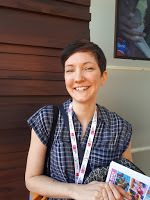
Paula Bowles-Illustrator
DO-bring a sketch book. Also bring a sandwich- the queues for the snack bars are long!
DON'T-rush around too much. There's a lot to see. Take your time!
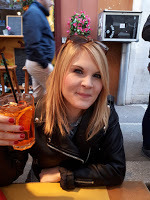
Laura Roberts- Executive Editor, Illustrated Publishing, Bloomsbury
DO-wear comfortable shoes if you're walking around the fair all day!
DON'T - be afraid to talk to people. You never know who or what in children's publishing you might have in common.

Yuval Zommer-Author/Illustrator
DO-at every opportunity, go into the courtyard and sit down with your sketch book. Book lovers are good at posing naturally. There are big portfolios and big crowds! It's great for people-drawing. You are spoilt for choice. It's not always easy to talk to the publishers. It can be hard to get a spot so you need to book ahead- it's much easier to draw people! And if you love books and you love people, well, you can't find a place that's more full of books and people! Also, DO pay attention on the plane- you can meet Frances Hardinge and she really does wear a hat!
DON'T-Take the early morning flight because once you're here it's absolutely all happening! It's not a quiet place to look around!
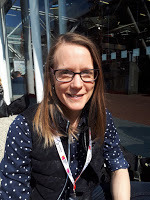
Lou Carter- Picture Book Author
DO- consider coming to the fair for 2 days so that it's not so overwhelming. There is a lot to see!
DON'T-forget to check out the weather before you come- it can be quite changeable! (And do remember to bring a coat!)

Ben Mantle-Children's Author and Illustrator
DO-plan ahead. There are lots of good talks and exhibitions at the fair. Another top tip- if you're an illustrator, you can buy an early bird discounted ticket so keep an eye out for that.
DON'T- arrive on the Monday morning. Give yourself a chance to explore and settle in over the weekend.

Jessica Wickham-Events and Marketing
DO- make time to explore the rest of Bologna- it's beautiful!
DON'T- forget to pick up an exhibition map at the entrance so that you fully explore the fair- it's big!

Mark Chambers-Illustrator
DO- try to look at as much as you can and explore all the different areas of the fair.
DON'T - be afraid to go on to a stand and introduce yourself but don't put too much pressure on yourself either- just enjoy the experience.

Penny Morris- Associate Publisher- Macmillan Children's Books
DO- be open to everybody because you never know when an opportunity will come along.
DON'T- stay up too late every night. Keep it to the last night!
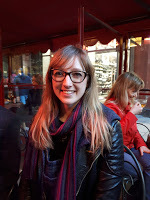
Alice McKinley- Children's Illustrator. Alice has just completed her MA at the Cambridge School of Arts.
DO- make sure you bring lots of food and drink to the fair and stay hydrated!
DON'T- get too drunk at the Swine bar!

Greg Gormley-Picture book author
DO- use the toilets near to the entrance- they're less busy than the rest.
DON'T- feel you have to spend the entire day at the fair. It's huge and you'll crash and burn!
 Tim Budgen -Children's Book Illustrator
Tim Budgen -Children's Book Illustrator
DO- bring your own packed lunch and water, and a big bag to stuff everything in! Also pick up lots of freebies!
DON'T - be too demanding and annoy the people on the front desks of publishing stands- they don't like it! :)
 Lucy Rowland- Picture book author
Lucy Rowland- Picture book author
My own thoughts...well, just the one really:
DO- go to Bologna! If you're wondering whether or not it is a worth while trip, I'd say, in my experience, YES it definitely is! It's not all about exposure and formal meetings with publishers but about meeting other creative people who love children's literature and children's illustration as much as you. It's about immersing yourself in the world of children's books. It's about getting inspired, getting ideas, getting to know people (and getting a bit tipsy on Aperol Spritzes!)
And finally, from our previous Children's Laureate and Author/Illustrator extraodinaire, Chris Riddell (who is shown in the photo christening the Macmillan's illustrator board at their 175th birthday celebrations) comes the following advice:
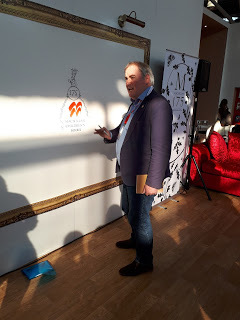
DO- go with the flow at the Bologna Book Fair
DON'T- over plan!
Have you been to the Bologna Children's Book Fair before? What are your Do's and Don'ts to make the most of the trip?
I was very excited this year to spot my new picture book with illustrator Kate Hindley, which was proudly displayed on the Nosy Crow Stand. 'The Knight Who Said No' is out on 5th April.
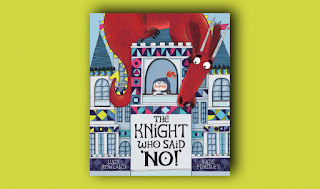
But arriving at the book fair can sometime feel a little overwhelming. Whether your a regular Bologna Book Fair goer or whether it's your very first time, the book fair is HUGE and there is such a lot to see and do. Where do you start? I asked for some top tips from those in the know. Authors, Illustrators, Editors and even our previous Children's Laureate, Chris Riddell, gave me some of their Bologna 'Do's and Don'ts'.

Benji Davies-Picture book writer and artist.
DO- take some time to explore Bologna itself and not just the fair. It's a beautiful city.
DON'T- feel too overwhelmed by the whole experience-take your time to enjoy it.

Paula Bowles-Illustrator
DO-bring a sketch book. Also bring a sandwich- the queues for the snack bars are long!
DON'T-rush around too much. There's a lot to see. Take your time!

Laura Roberts- Executive Editor, Illustrated Publishing, Bloomsbury
DO-wear comfortable shoes if you're walking around the fair all day!
DON'T - be afraid to talk to people. You never know who or what in children's publishing you might have in common.

Yuval Zommer-Author/Illustrator
DO-at every opportunity, go into the courtyard and sit down with your sketch book. Book lovers are good at posing naturally. There are big portfolios and big crowds! It's great for people-drawing. You are spoilt for choice. It's not always easy to talk to the publishers. It can be hard to get a spot so you need to book ahead- it's much easier to draw people! And if you love books and you love people, well, you can't find a place that's more full of books and people! Also, DO pay attention on the plane- you can meet Frances Hardinge and she really does wear a hat!
DON'T-Take the early morning flight because once you're here it's absolutely all happening! It's not a quiet place to look around!

Lou Carter- Picture Book Author
DO- consider coming to the fair for 2 days so that it's not so overwhelming. There is a lot to see!
DON'T-forget to check out the weather before you come- it can be quite changeable! (And do remember to bring a coat!)

Ben Mantle-Children's Author and Illustrator
DO-plan ahead. There are lots of good talks and exhibitions at the fair. Another top tip- if you're an illustrator, you can buy an early bird discounted ticket so keep an eye out for that.
DON'T- arrive on the Monday morning. Give yourself a chance to explore and settle in over the weekend.

Jessica Wickham-Events and Marketing
DO- make time to explore the rest of Bologna- it's beautiful!
DON'T- forget to pick up an exhibition map at the entrance so that you fully explore the fair- it's big!

Mark Chambers-Illustrator
DO- try to look at as much as you can and explore all the different areas of the fair.
DON'T - be afraid to go on to a stand and introduce yourself but don't put too much pressure on yourself either- just enjoy the experience.

Penny Morris- Associate Publisher- Macmillan Children's Books
DO- be open to everybody because you never know when an opportunity will come along.
DON'T- stay up too late every night. Keep it to the last night!

Alice McKinley- Children's Illustrator. Alice has just completed her MA at the Cambridge School of Arts.
DO- make sure you bring lots of food and drink to the fair and stay hydrated!
DON'T- get too drunk at the Swine bar!

Greg Gormley-Picture book author
DO- use the toilets near to the entrance- they're less busy than the rest.
DON'T- feel you have to spend the entire day at the fair. It's huge and you'll crash and burn!
 Tim Budgen -Children's Book Illustrator
Tim Budgen -Children's Book Illustrator DO- bring your own packed lunch and water, and a big bag to stuff everything in! Also pick up lots of freebies!
DON'T - be too demanding and annoy the people on the front desks of publishing stands- they don't like it! :)
 Lucy Rowland- Picture book author
Lucy Rowland- Picture book authorMy own thoughts...well, just the one really:
DO- go to Bologna! If you're wondering whether or not it is a worth while trip, I'd say, in my experience, YES it definitely is! It's not all about exposure and formal meetings with publishers but about meeting other creative people who love children's literature and children's illustration as much as you. It's about immersing yourself in the world of children's books. It's about getting inspired, getting ideas, getting to know people (and getting a bit tipsy on Aperol Spritzes!)
And finally, from our previous Children's Laureate and Author/Illustrator extraodinaire, Chris Riddell (who is shown in the photo christening the Macmillan's illustrator board at their 175th birthday celebrations) comes the following advice:

DO- go with the flow at the Bologna Book Fair
DON'T- over plan!
Have you been to the Bologna Children's Book Fair before? What are your Do's and Don'ts to make the most of the trip?
I was very excited this year to spot my new picture book with illustrator Kate Hindley, which was proudly displayed on the Nosy Crow Stand. 'The Knight Who Said No' is out on 5th April.

Published on April 01, 2018 22:00
March 19, 2018
Picture Books to Share on an Allotment by Cath Jones
Anyone who knows me will agree that I’m BONKERS about growing vegetables and BONKERS about picture books. It’s not a huge surprise then that my debut picture book, Bonkers About Beetroot, is about a group of animals who decide to grow a giant beetroot.
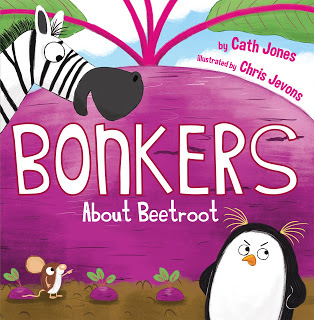
Spring is my favourite time of year in the garden. The growing season is just beginning; the greenhouse is filling up with seed trays and seeds are bursting into life. Right now, thousands of people are heading for their allotments! But if you’ve got children along to help, sometimes it can be tricky to engage them in gardening activities, particularly for extended periods. My top tip for keeping kids happy on an allotment is to take the right picture books with you. So when they have had enough of digging holes and they don’t really want to help tidy up they won’t be bored!
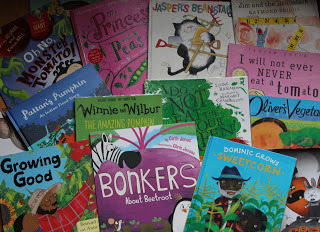
I used to manage a community allotment and naturally the project’s focus was on children. At the end of every gardening session I shared picture book stories with the young gardeners. I tracked down lots of books that featured vegetables or gardening as their main theme. My picture book collection grew and grew, much like our vegetables. And of course it was growing beetroot with the children that inspired my story about a BONKERS beetroot eating zebra! I now volunteer on a local community allotment with a family group and get to share my own picture book with them.
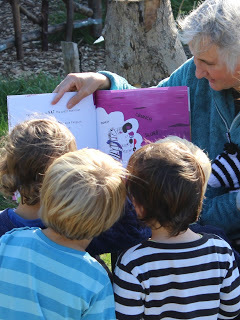
I’m sure there are many vegetable themed and gardening related picture books that I have not discovered yet. But I do have a few firm favourites which I hope you will enjoy while doing a bit of gardening with the kids. For some reason the ones I like the most all feature carrots. And yes, I do have an idea for my own carrot related story...
In no particular order, picture books that I think work really well on allotments are:
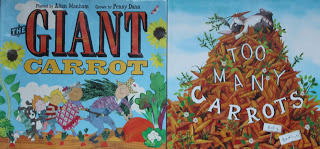
The Giant Carrot by Allan Manham and Penny Dann. I love sharing this one down on the plot. It’s a great one for getting the kids to join in with.Too Many Carrots by Katy Hudson. This has always been hugely popular. The text is perfect and it’s beautifully illustrated too.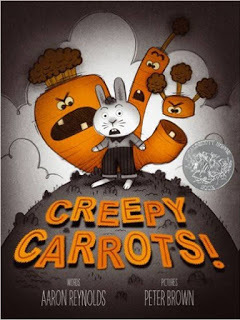
Creepy Carrots by Aaron Reynolds and Peter Brown. This one is great for sharing one to one. It’s a bit scary! It has really fabulous illustration inspired by Hitchcock films.
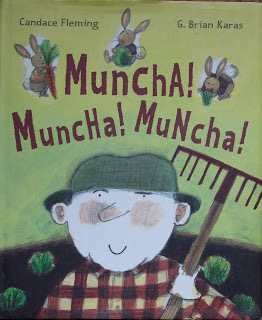
Muncha! Muncha! Muncha! By Candace Fleming and G. Brian Karas. This a delightful story that shows the central character growing carrots and harvesting them as well as defending them! It’s great for joining in with and very funny.

Pattan’s Pumpkin by Chitra Soundar and Frane Lessac. This is a great choice if you are having a competition to see who can grow the biggest pumpkin. The text is so lovely; it’s a joy to read aloud.
If you are looking for stories that deal in particular with growing food then the following are ideal: Grow Your Own by Esther Hall.
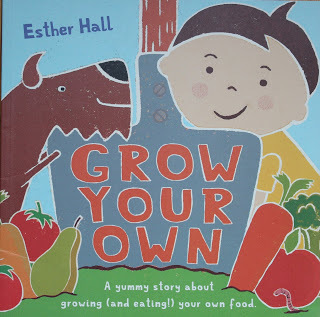
Growing Good by Bernard Ashley and Anne Wilson
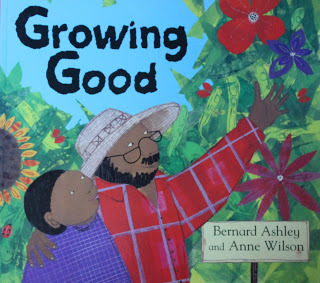 and Dominic Grows Sweetcorn by Mandy Ross and Alison Bartlett.
and Dominic Grows Sweetcorn by Mandy Ross and Alison Bartlett.
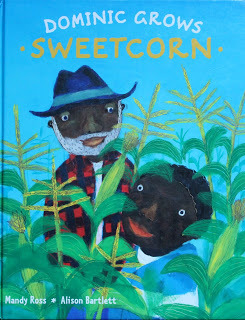
My own Bonkers About Beetroot is also good for showing how to grow seeds.
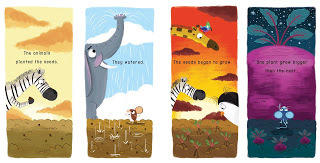
There are many more titles I could suggest but right now I’m heading off to my greenhouse. I’ve got some beetroot seeds to deal with!
Wishing you a great growing season and I hope the kids in your life will feel inspired by all these wonderful picture books. If I have missed out a book you particularly love to read down on the plot, please do share in the comments section.
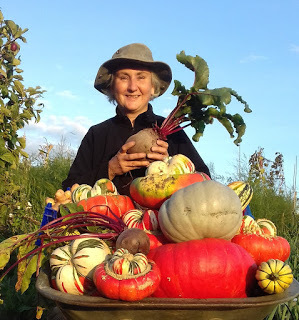
Cath Jones is the author of quirky picture book Bonkers About Beetroot and lots of early and reluctant readers. She also writes junior and middle grade fiction. Her whole life has been about books: as a librarian, teacher, editor, community gardener (vegetable story-time anyone?), and now an author she has always aimed to inspire a love of stories. She loves sharing her stories with children of all ages in libraries, bookshops, schools and especially on allotments.

Spring is my favourite time of year in the garden. The growing season is just beginning; the greenhouse is filling up with seed trays and seeds are bursting into life. Right now, thousands of people are heading for their allotments! But if you’ve got children along to help, sometimes it can be tricky to engage them in gardening activities, particularly for extended periods. My top tip for keeping kids happy on an allotment is to take the right picture books with you. So when they have had enough of digging holes and they don’t really want to help tidy up they won’t be bored!

I used to manage a community allotment and naturally the project’s focus was on children. At the end of every gardening session I shared picture book stories with the young gardeners. I tracked down lots of books that featured vegetables or gardening as their main theme. My picture book collection grew and grew, much like our vegetables. And of course it was growing beetroot with the children that inspired my story about a BONKERS beetroot eating zebra! I now volunteer on a local community allotment with a family group and get to share my own picture book with them.

I’m sure there are many vegetable themed and gardening related picture books that I have not discovered yet. But I do have a few firm favourites which I hope you will enjoy while doing a bit of gardening with the kids. For some reason the ones I like the most all feature carrots. And yes, I do have an idea for my own carrot related story...
In no particular order, picture books that I think work really well on allotments are:

The Giant Carrot by Allan Manham and Penny Dann. I love sharing this one down on the plot. It’s a great one for getting the kids to join in with.Too Many Carrots by Katy Hudson. This has always been hugely popular. The text is perfect and it’s beautifully illustrated too.

Creepy Carrots by Aaron Reynolds and Peter Brown. This one is great for sharing one to one. It’s a bit scary! It has really fabulous illustration inspired by Hitchcock films.

Muncha! Muncha! Muncha! By Candace Fleming and G. Brian Karas. This a delightful story that shows the central character growing carrots and harvesting them as well as defending them! It’s great for joining in with and very funny.

Pattan’s Pumpkin by Chitra Soundar and Frane Lessac. This is a great choice if you are having a competition to see who can grow the biggest pumpkin. The text is so lovely; it’s a joy to read aloud.
If you are looking for stories that deal in particular with growing food then the following are ideal: Grow Your Own by Esther Hall.

Growing Good by Bernard Ashley and Anne Wilson
 and Dominic Grows Sweetcorn by Mandy Ross and Alison Bartlett.
and Dominic Grows Sweetcorn by Mandy Ross and Alison Bartlett. 
My own Bonkers About Beetroot is also good for showing how to grow seeds.

There are many more titles I could suggest but right now I’m heading off to my greenhouse. I’ve got some beetroot seeds to deal with!
Wishing you a great growing season and I hope the kids in your life will feel inspired by all these wonderful picture books. If I have missed out a book you particularly love to read down on the plot, please do share in the comments section.

Cath Jones is the author of quirky picture book Bonkers About Beetroot and lots of early and reluctant readers. She also writes junior and middle grade fiction. Her whole life has been about books: as a librarian, teacher, editor, community gardener (vegetable story-time anyone?), and now an author she has always aimed to inspire a love of stories. She loves sharing her stories with children of all ages in libraries, bookshops, schools and especially on allotments.
Published on March 19, 2018 01:44
March 11, 2018
Who Chooses The Books? By Pippa Goodhart
I buy lots of picture books. My children are now in their twenties, and I don't yet have grandchildren, so I buy picture books for me. I buy ones I just want to enjoy for myself, but I also buy books with thoughts of using them as examples when I teach classes of adults about writing children's books.
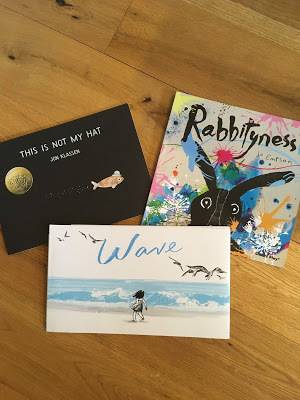
I love the clever, super-charged, thrill and danger of picture books such as Jon Klassen's This Is Not My Hat. I'm moved to sadness and joy by books such as Jo Empson's Rabbityness. I love the gentle beauty and humour of wordless book Wave by Suzy Lee.
But, looking at my books, I wondered which of them the young child me would have chosen. We're all individual as children just as we're individual as adults. But I know that child me was also different from adult me. So I went through the books, thinking about what would have appealed or not when I was of core picture book audience age. I picked out two books.
I would have hugely enjoyed Oi Frog by Kes Gray and Jim Field for its wonderfully logical silliness and humour, and the way it plays with language.
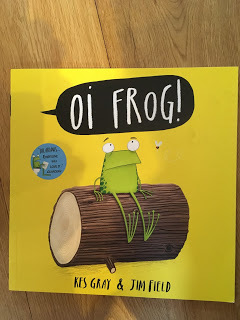
But I know that the book I would have gone back to again and again on my own after a parent had first read it to me would have been Mr Tiger Goes Wild by Peter Brown. Why? Because it is beautiful. But, more than that, because Mr Tiger goes through emotions that I would have recognised as he copes with feeling an odd one out, testing freedoms, then coming to a happy compromise that lets him both be himself and fit into society. It's a story I would have thought about a lot, and probably made up extension stories of my own in my head about. I care about Mr Tiger, and would have done so then.
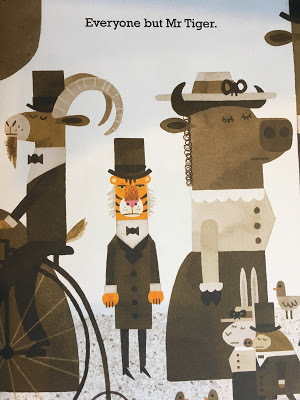
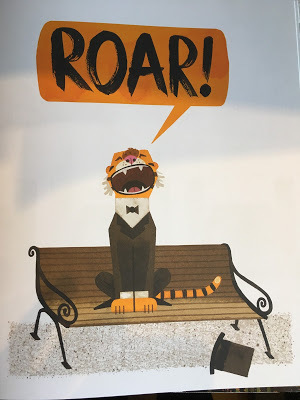
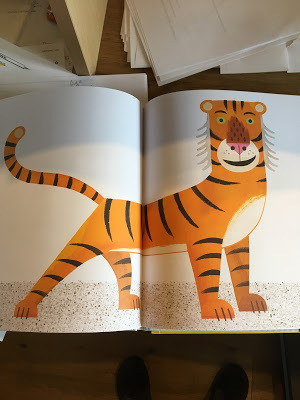
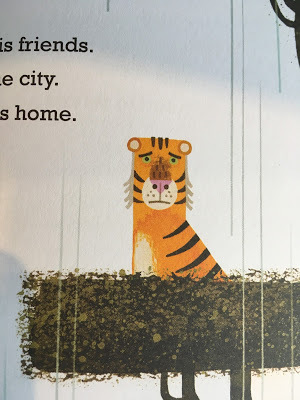

I would also have enjoyed having a go at copying those wonderful blocky pictures.
So what modern picture book would the child you have particularly enjoyed, and why?

I love the clever, super-charged, thrill and danger of picture books such as Jon Klassen's This Is Not My Hat. I'm moved to sadness and joy by books such as Jo Empson's Rabbityness. I love the gentle beauty and humour of wordless book Wave by Suzy Lee.
But, looking at my books, I wondered which of them the young child me would have chosen. We're all individual as children just as we're individual as adults. But I know that child me was also different from adult me. So I went through the books, thinking about what would have appealed or not when I was of core picture book audience age. I picked out two books.
I would have hugely enjoyed Oi Frog by Kes Gray and Jim Field for its wonderfully logical silliness and humour, and the way it plays with language.

But I know that the book I would have gone back to again and again on my own after a parent had first read it to me would have been Mr Tiger Goes Wild by Peter Brown. Why? Because it is beautiful. But, more than that, because Mr Tiger goes through emotions that I would have recognised as he copes with feeling an odd one out, testing freedoms, then coming to a happy compromise that lets him both be himself and fit into society. It's a story I would have thought about a lot, and probably made up extension stories of my own in my head about. I care about Mr Tiger, and would have done so then.





I would also have enjoyed having a go at copying those wonderful blocky pictures.
So what modern picture book would the child you have particularly enjoyed, and why?
Published on March 11, 2018 17:30
March 4, 2018
My 10 Step Marketing Plan • by Natascha Biebow
So, after years of tinkering and not giving up, I’m super excited that I have finally got a new book coming out in Spring 2019. THE CRAYON MAN is a narrative non-fiction picture book about the invention of the Crayola crayon.
<!-- /* Font Definitions */ @font-face {font-family:"MS 明朝"; mso-font-charset:78; mso-generic-font-family:auto; mso-font-pitch:variable; mso-font-signature:1 134676480 16 0 131072 0;} @font-face {font-family:"Cambria Math"; panose-1:2 4 5 3 5 4 6 3 2 4; mso-font-charset:0; mso-generic-font-family:auto; mso-font-pitch:variable; mso-font-signature:-536870145 1107305727 0 0 415 0;} @font-face {font-family:Calibri; panose-1:2 15 5 2 2 2 4 3 2 4; mso-font-charset:0; mso-generic-font-family:auto; mso-font-pitch:variable; mso-font-signature:-520092929 1073786111 9 0 415 0;} /* Style Definitions */ p.MsoNormal, li.MsoNormal, div.MsoNormal {mso-style-unhide:no; mso-style-qformat:yes; mso-style-parent:""; margin:0cm; margin-bottom:.0001pt; mso-pagination:widow-orphan; font-size:12.0pt; font-family:"Times New Roman"; mso-fareast-font-family:"MS 明朝"; mso-fareast-theme-font:minor-fareast; mso-ansi-language:EN-US;} .MsoChpDefault {mso-style-type:export-only; mso-default-props:yes; font-size:10.0pt; mso-ansi-font-size:10.0pt; mso-bidi-font-size:10.0pt; mso-fareast-font-family:"MS 明朝"; mso-fareast-theme-font:minor-fareast; mso-fareast-language:JA;} @page WordSection1 {size:612.0pt 792.0pt; margin:72.0pt 90.0pt 72.0pt 90.0pt; mso-header-margin:36.0pt; mso-footer-margin:36.0pt; mso-paper-source:0;} div.WordSection1 {page:WordSection1;} </style> </span></span></div><div class="MsoNormal"><i style="mso-bidi-font-style: normal;"><span lang="EN-US" style="font-family: "calibri";"><span style="font-family: "trebuchet ms" , sans-serif;">It is a colourful jaunt into the invention of one of America’s signature childhood toys: <i>In 1903, a man’s innovative invention appeared in homes in a bright green box – the Crayola crayons.</i> In a world where children are given crayons almost as soon as they are born, where the smell of crayons is more recognizable than coffee and peanut butter, I wondered: what must it have been like to live at a time when crayons were a novelty? </span></span></i><br /><br /></div><div class="MsoNormal"></div><table align="center" cellpadding="0" cellspacing="0" class="tr-caption-container" style="margin-left: auto; margin-right: auto; text-align: center;"><tbody><tr><td style="text-align: center;"><a href="https://1.bp.blogspot.com/-M-_r-r3KgB..." imageanchor="1" style="margin-left: auto; margin-right: auto;"><img border="0" data-original-height="367" data-original-width="260" height="320" src="https://1.bp.blogspot.com/-M-_r-r3KgB..." width="226" /></a></td></tr><tr><td class="tr-caption" style="text-align: center;">Original box of 8 launched in 1903. Image from crayoncollecting.com</td></tr></tbody></table><div class="MsoNormal"><span style="font-family: "trebuchet ms" , sans-serif;"><span lang="EN-US"></span></span></div><span style="font-family: "trebuchet ms" , sans-serif;"> </span> <br /><div class="MsoNormal"><span style="font-family: "trebuchet ms" , sans-serif;"><span lang="EN-US">Oooh, I'm so excited. </span></span> </div><div class="MsoNormal"></div><span style="font-family: "trebuchet ms" , sans-serif;"></span> <br /><div class="separator" style="clear: both; text-align: center;"><a href="https://1.bp.blogspot.com/-LsV-AgyS8-..." imageanchor="1" style="clear: right; float: right; margin-bottom: 1em; margin-left: 1em;"><img border="0" data-original-height="339" data-original-width="602" height="180" src="https://1.bp.blogspot.com/-LsV-AgyS8-..." width="320" /></a></div><div class="MsoNormal"><span style="font-family: "trebuchet ms" , sans-serif;"><span lang="EN-US">Last September, I went to the SCBWI Author Bootcamp to learn about how to market my book. I came away with lots of practical advice and a list in my notebook. But since then I have, well, hidden under my rock. I figured I had bags of time still. </span></span><br /><span style="font-family: "trebuchet ms" , sans-serif;"><span lang="EN-US"> </span></span> </div><div class="MsoNormal"></div><div class="MsoNormal"><span style="font-family: "trebuchet ms" , sans-serif;"><span lang="EN-US">Then last week my publisher sent me a marketing questionnaire. </span></span></div><div class="MsoNormal"></div><div class="MsoNormal"><br /><span style="font-family: "trebuchet ms" , sans-serif;"><span lang="EN-US">Hmm, maybe I should crawl out from under my rock . . . </span></span><br /><span style="font-family: "trebuchet ms" , sans-serif;"><span lang="EN-US"> </span></span></div><div class="MsoNormal"></div><div class="separator" style="clear: both; text-align: center;"><a href="https://3.bp.blogspot.com/-wVppnU2nHi..." imageanchor="1" style="clear: left; float: left; margin-bottom: 1em; margin-right: 1em;"><img border="0" data-original-height="226" data-original-width="414" height="174" src="https://3.bp.blogspot.com/-wVppnU2nHi..." width="320" /></a></div><div class="separator" style="clear: both; text-align: center;"></div><div class="MsoNormal"><span style="font-family: "trebuchet ms" , sans-serif;"><span lang="EN-US">. . . and think about starting to do some, erm, </span><span lang="EN-US" style="font-size: 8.0pt; mso-bidi-font-size: 12.0pt;">Marketing.</span></span></div><div class="MsoNormal"></div><span style="font-family: "trebuchet ms" , sans-serif;"> </span> <br /><div class="MsoNormal"><span style="font-family: "trebuchet ms" , sans-serif;"><span lang="EN-US">It’s one of those words that, for me, is like when my mum used to announce something I didn't like to eat for dinner, like fried liver with apples. It made my stomach clench in anticipation.</span></span></div><span style="font-family: "trebuchet ms" , sans-serif;"> </span> <br /><div class="MsoNormal"></div><div class="MsoNormal"><span style="font-family: "trebuchet ms" , sans-serif;"><span lang="EN-US">When I got the questionnaire, I decided to see if I could come up with a marketing plan. And, um, maybe you can help?</span></span></div><span style="font-family: "trebuchet ms" , sans-serif;"> </span> <br /><div class="MsoNormal"></div><span style="font-family: "trebuchet ms" , sans-serif;"> </span> <br /><div class="MsoNormal"><span style="font-family: "trebuchet ms" , sans-serif;"><span lang="EN-US">1. Hide under my rock. </span></span></div><span style="font-family: "trebuchet ms" , sans-serif;"></span> <br /><div class="separator" style="clear: both; text-align: center;"><a href="https://4.bp.blogspot.com/-OGETFlJkQR..." imageanchor="1" style="margin-left: 1em; margin-right: 1em;"><img border="0" data-original-height="213" data-original-width="439" height="155" src="https://4.bp.blogspot.com/-OGETFlJkQR..." width="320" /></a></div><div class="separator" style="clear: both; text-align: center;"></div><div class="MsoNormal"><span style="font-family: "trebuchet ms" , sans-serif;"><span lang="EN-US"> </span></span></div><div class="MsoNormal"><span style="font-family: "trebuchet ms" , sans-serif;"><span lang="EN-US"></span></span></div><span style="font-family: "trebuchet ms" , sans-serif;"> </span> <br /><div class="MsoNormal"><span style="font-family: "trebuchet ms" , sans-serif;"><span lang="EN-US">No, actually the Bootcamp list says: <span style="background-color: yellow;">don't forget to work on the next book.</span> Yes! I can do that. I’ve been researching and writing some more non-fiction picture books, because I want to keep up the momentum and actually get to have coffee and cake with my lovely new editor at some point soon. </span></span><br /><span style="font-family: "trebuchet ms" , sans-serif;"><span lang="EN-US"> </span></span></div><div class="MsoNormal"></div><div class="MsoNormal"><span style="font-family: "trebuchet ms" , sans-serif;"><span lang="EN-US">But that's not really MARKETING . . . Right. The Bootcamp notes. </span></span></div><span style="font-family: "trebuchet ms" , sans-serif;"> </span> <br /><div class="MsoNormal"></div><span style="font-family: "trebuchet ms" , sans-serif;"> </span> <br /><div class="MsoNormal"><span style="font-family: "trebuchet ms" , sans-serif;"><span lang="EN-US">2.<span style="background-color: yellow;"> Blog.<span style="background-color: white;"> </span></span>I like writing. Yes, I can do those. Blogs are my friend. I blog here and I have a new blog for the SCBWI’s <i style="mso-bidi-font-style: normal;">Words & Pictures</i> online magazine:</span></span></div><div class="MsoNormal"></div><div class="MsoNormal"><span style="font-family: "trebuchet ms" , sans-serif;"><span lang="EN-US"></span></span></div><div class="separator" style="clear: both; text-align: center;"></div><div class="separator" style="clear: both; text-align: center;"><a href="http://www.wordsandpics.org/2018/02/p..." target="_blank"><img alt="http://www.wordsandpics.org/2018/02/p..." border="0" data-original-height="548" data-original-width="1267" height="172" src="https://1.bp.blogspot.com/-3vw4-921_T..." title="Picture Book Storyshaper" width="400" /></a></div><div class="MsoNormal"><span style="font-family: "trebuchet ms" , sans-serif;"><span lang="EN-US">To do: Write a couple of blog posts about topics like how the book came about, a glimpse behind the scenes, and perhaps even with some updates on this plan. <span style="color: blue;">What else?</span></span></span></div><span style="font-family: "trebuchet ms" , sans-serif;"> </span> <br /><div class="MsoNormal"></div><span style="font-family: "trebuchet ms" , sans-serif;"> </span> <br /><div class="MsoNormal"><span style="font-family: "trebuchet ms" , sans-serif;"><span lang="EN-US">3.<span style="background-color: yellow;"><span style="background-color: white;"> </span>Website:</span> I’ve already used jimdo.com to build one of those for my coaching and mentoring service. So, I grab nataschabiebow.com and start building an author website. But, what should it have on it?<span style="color: blue;"> It’s a darned blank page!</span></span></span></div><span style="font-family: "trebuchet ms" , sans-serif;"> </span> <br /><div class="MsoNormal"></div><span style="font-family: "trebuchet ms" , sans-serif;"> </span> <br /><div class="MsoNormal"><span style="font-family: "trebuchet ms" , sans-serif;"><span lang="EN-US">I want to crawl back under my rock. <span style="color: blue;">No, come on,</span> I coach myself. <span style="color: blue;">Chunk it down.</span> Bring it back to writing. </span></span></div><span style="font-family: "trebuchet ms" , sans-serif;"> </span> <br /><div class="MsoNormal"></div><span style="font-family: "trebuchet ms" , sans-serif;"> </span> <br /><div class="MsoNormal"><span style="font-family: "trebuchet ms" , sans-serif;"><span lang="EN-US">Maybe I could share: </span></span></div><span style="font-family: "trebuchet ms" , sans-serif;"> </span> <br /><div class="MsoNormal"></div><span style="font-family: "trebuchet ms" , sans-serif;"> </span> <br /><div class="MsoListParagraphCxSpFirst" style="mso-list: l1 level1 lfo2; text-indent: -18.0pt;"><span style="font-family: "trebuchet ms" , sans-serif;"><span lang="EN-US" style="mso-fareast-font-family: "Times New Roman";"><span style="mso-list: Ignore;">-<span style="font-feature-settings: normal; font-kerning: auto; font-language-override: normal; font-size-adjust: none; font-size: 7pt; font-stretch: normal; font-style: normal; font-variant: normal; font-weight: normal; line-height: normal;"> </span></span></span><span lang="EN-US">some quirky info about me Like this:</span></span></div><div class="MsoListParagraphCxSpFirst" style="mso-list: l1 level1 lfo2; text-indent: -18.0pt;"><span style="font-family: "trebuchet ms" , sans-serif;"><span lang="EN-US"></span></span></div><div class="MsoListParagraphCxSpFirst" style="mso-list: l1 level1 lfo2; text-indent: -18.0pt;"><span style="font-family: "trebuchet ms" , sans-serif;"> <span style="color: blue;">Whenever I go anywhere, I always have a book (or usually books) in my bag -- IN CASE. I think my greatest fear is being stuck somewhere without a book . . .</span></span><span style="color: blue;"> </span></div><div class="separator" style="clear: both; text-align: center;"></div><span style="color: blue;"> </span> <br /><div class="separator" style="clear: both; text-align: center;"><span style="color: blue;"><a href="http://3.bp.blogspot.com/-yu4A5wx0uzQ..." style="margin-left: 1em; margin-right: 1em;"><img border="0" src="https://3.bp.blogspot.com/-yu4A5wx0uz..." /></a></span></div><span style="color: blue;"> <span style="font-family: "trebuchet ms" , sans-serif;"> . . . (and chocolate)!</span></span><span style="font-family: "trebuchet ms" , sans-serif;"></span> <br /><div class="MsoListParagraphCxSpFirst" style="mso-list: l1 level1 lfo2; text-indent: -18.0pt;"><span style="font-family: "trebuchet ms" , sans-serif;"><span lang="EN-US"></span></span></div><span style="font-family: "trebuchet ms" , sans-serif;"> </span> <br /><div class="MsoListParagraphCxSpMiddle" style="mso-list: l1 level1 lfo2; text-indent: -18.0pt;"><span style="font-family: "trebuchet ms" , sans-serif;"><span lang="EN-US" style="mso-fareast-font-family: "Times New Roman";"><span style="mso-list: Ignore;">-<span style="font-feature-settings: normal; font-kerning: auto; font-language-override: normal; font-size-adjust: none; font-size: 7pt; font-stretch: normal; font-style: normal; font-variant: normal; font-weight: normal; line-height: normal;"> </span></span></span><span lang="EN-US">the book cover (can’t wait to see that!), a blurb with THE CRAYON MAN hook and links to bookshops</span></span></div><span style="font-family: "trebuchet ms" , sans-serif;"> </span> <br /><div class="MsoListParagraphCxSpMiddle" style="mso-list: l1 level1 lfo2; text-indent: -18.0pt;"><span style="font-family: "trebuchet ms" , sans-serif;"><span lang="EN-US" style="mso-fareast-font-family: "Times New Roman";"><span style="mso-list: Ignore;">-<span style="font-feature-settings: normal; font-kerning: auto; font-language-override: normal; font-size-adjust: none; font-size: 7pt; font-stretch: normal; font-style: normal; font-variant: normal; font-weight: normal; line-height: normal;"> </span></span></span><span lang="EN-US">tips for readers and teachers about using the book in the classroom (I coach writers and illustrators, and I’m a Montessori teacher so that should be do-able), and maybe some useful non-fiction links and activity sheets.</span></span><span style="font-family: "trebuchet ms" , sans-serif;"><span lang="EN-US"> </span></span></div><span style="font-family: "trebuchet ms" , sans-serif;"> </span> <br /><div class="MsoListParagraphCxSpMiddle" style="mso-list: l1 level1 lfo2; text-indent: -18.0pt;"><span style="font-family: "trebuchet ms" , sans-serif;"><span lang="EN-US" style="mso-fareast-font-family: "Times New Roman";"><span style="mso-list: Ignore;">-<span style="font-feature-settings: normal; font-kerning: auto; font-language-override: normal; font-size-adjust: none; font-size: 7pt; font-stretch: normal; font-style: normal; font-variant: normal; font-weight: normal; line-height: normal;"> </span></span></span><span lang="EN-US">some info about school visits</span></span></div><span style="font-family: "trebuchet ms" , sans-serif;"> </span> <br /><div class="MsoListParagraphCxSpLast" style="mso-list: l1 level1 lfo2; text-indent: -18.0pt;"><span style="font-family: "trebuchet ms" , sans-serif;"><span lang="EN-US" style="mso-fareast-font-family: "Times New Roman";"><span style="mso-list: Ignore;">-<span style="font-feature-settings: normal; font-kerning: auto; font-language-override: normal; font-size-adjust: none; font-size: 7pt; font-stretch: normal; font-style: normal; font-variant: normal; font-weight: normal; line-height: normal;"> </span></span></span><span lang="EN-US">link to my blogs<br style="mso-special-character: line-break;" /> <br style="mso-special-character: line-break;" /> </span></span></div><span style="font-family: "trebuchet ms" , sans-serif;"> </span> <br /><div class="MsoNormal"><span style="font-family: "trebuchet ms" , sans-serif;"><span lang="EN-US">Better get writing then and oooh, maybe do some colouring. <span style="color: blue;"> </span></span></span><br /></div><div class="MsoNormal"></div><div class="MsoNormal"><span style="font-family: "trebuchet ms" , sans-serif;"><span lang="EN-US"><span style="color: blue;"></span></span></span></div><div class="separator" style="clear: both; text-align: center;"></div><div class="separator" style="clear: both; text-align: center;"><a href="https://4.bp.blogspot.com/-ATQudjs-Le..." imageanchor="1" style="margin-left: 1em; margin-right: 1em;"><img border="0" data-original-height="258" data-original-width="386" height="213" src="https://4.bp.blogspot.com/-ATQudjs-Le..." width="320" /></a></div><div class="MsoNormal"></div><div class="MsoNormal"></div><div class="MsoNormal"><br /><span style="font-family: "trebuchet ms" , sans-serif;"><span lang="EN-US"><span style="color: blue;">But when? I'm supposed to be writing a new book (and working to earn a living).</span></span></span></div><span style="font-family: "trebuchet ms" , sans-serif;"> </span> <br /><div class="MsoNormal"></div><span style="font-family: "trebuchet ms" , sans-serif;"> </span> <br /><span style="font-family: "trebuchet ms" , sans-serif;"> </span> <br /><div class="MsoNormal"></div><span style="font-family: "trebuchet ms" , sans-serif;"> </span> <br /><div class="MsoNormal"><span style="font-family: "trebuchet ms" , sans-serif;"><span lang="EN-US">4. Create some freebies: <span style="background-color: yellow;">postcards/bookmarks?</span> Or someone suggested a fun rubberised stamp saying “I met an author today”. <span style="color: blue;">Design and print.</span></span></span></div><span style="font-family: "trebuchet ms" , sans-serif;"> </span> <br /><div class="MsoNormal"></div><span style="font-family: "trebuchet ms" , sans-serif;"> </span> <br /><div class="MsoNormal"><span style="font-family: "trebuchet ms" , sans-serif;"><span lang="EN-US">5. Dream up and <span style="background-color: yellow;">plan a school visit gig</span>: <span style="color: blue;">hmmm, this one sounds a tad big and overwhelming.</span> How to start? Oooh, I know, <span style="color: purple;">PROPS! </span></span></span><span style="font-family: "trebuchet ms" , sans-serif;"></span><span style="font-family: "trebuchet ms" , sans-serif;"><span lang="EN-US"> I could buy some rearlly, cool stationery, like: </span></span><span style="font-family: "trebuchet ms" , sans-serif;"></span></div><div class="MsoNormal"></div><span style="font-family: "trebuchet ms" , sans-serif;"> </span> <br /><div class="MsoListParagraphCxSpFirst" style="mso-list: l0 level1 lfo1; text-indent: -18.0pt;"><span style="font-family: "trebuchet ms" , sans-serif;"><span lang="EN-US" style="mso-fareast-font-family: "Times New Roman";"><span style="mso-list: Ignore;">-<span style="font-feature-settings: normal; font-kerning: auto; font-language-override: normal; font-size-adjust: none; font-size: 7pt; font-stretch: normal; font-style: normal; font-variant: normal; font-weight: normal; line-height: normal;"> </span></span></span><span lang="EN-US">Slates and slate pencils </span></span></div><span style="font-family: "trebuchet ms" , sans-serif;"> </span> <br /><div class="MsoListParagraphCxSpMiddle" style="mso-list: l0 level1 lfo1; text-indent: -18.0pt;"><span style="font-family: "trebuchet ms" , sans-serif;"><span lang="EN-US" style="mso-fareast-font-family: "Times New Roman";"><span style="mso-list: Ignore;">-<span style="font-feature-settings: normal; font-kerning: auto; font-language-override: normal; font-size-adjust: none; font-size: 7pt; font-stretch: normal; font-style: normal; font-variant: normal; font-weight: normal; line-height: normal;"> </span></span></span><span lang="EN-US">Coloured chalk</span></span></div><span style="font-family: "trebuchet ms" , sans-serif;"> </span> <br /><div class="MsoListParagraphCxSpLast" style="mso-list: l0 level1 lfo1; text-indent: -18.0pt;"><span style="font-family: "trebuchet ms" , sans-serif;"><span lang="EN-US" style="mso-fareast-font-family: "Times New Roman";"><span style="mso-list: Ignore;">-<span style="font-feature-settings: normal; font-kerning: auto; font-language-override: normal; font-size-adjust: none; font-size: 7pt; font-stretch: normal; font-style: normal; font-variant: normal; font-weight: normal; line-height: normal;"> </span></span></span><span lang="EN-US">Lovely colourful Crayola crayons . . .</span></span></div><div class="MsoListParagraphCxSpLast" style="mso-list: l0 level1 lfo1; text-indent: -18.0pt;"><span style="font-family: "trebuchet ms" , sans-serif;"><span lang="EN-US"></span></span></div><div class="MsoListParagraphCxSpLast" style="mso-list: l0 level1 lfo1; text-indent: -18.0pt;"><span style="font-family: "trebuchet ms" , sans-serif;"><span lang="EN-US"><a href="http://4.bp.blogspot.com/-2AwSx2YNRrQ..." imageanchor="1"><img border="0" height="300" src="https://4.bp.blogspot.com/-2AwSx2YNRr..." width="400" /></a><br style="mso-special-character: line-break;" /> </span></span></div><span style="font-family: "trebuchet ms" , sans-serif;"> </span> <br /><div class="MsoNormal"><span style="font-family: "trebuchet ms" , sans-serif;"><span lang="EN-US">But I can't just colour with an assembly of 200 kids. The notes say I need a PRESENTATION. I need to brainstorm and plan out my visit. <span style="color: blue;">(Maybe I can work on this while walking the dog?!)</span></span></span><br /><br /></div><div class="MsoNormal"></div><div class="MsoNormal"><span style="font-family: "trebuchet ms" , sans-serif;"><span lang="EN-US">I need some ideas. I know: go and watch some seasoned authors perform.</span></span><br /><br /></div><div class="MsoNormal"></div><table align="center" cellpadding="0" cellspacing="0" class="tr-caption-container" style="margin-left: auto; margin-right: auto; text-align: center;"><tbody><tr><td style="text-align: center;"><a href="https://4.bp.blogspot.com/-_2yxwuWi8A..." imageanchor="1" style="margin-left: auto; margin-right: auto;"><img border="0" data-original-height="428" data-original-width="283" height="320" src="https://4.bp.blogspot.com/-_2yxwuWi8A..." width="211" /></a></td></tr><tr><td class="tr-caption" style="text-align: center;">Mo O'Hara enthralling school children.</td></tr></tbody></table><div class="MsoNormal"></div><div class="MsoNormal"><span style="font-family: "trebuchet ms" , sans-serif;"><span lang="EN-US">I wonder if I can come up with a party trick like Kes Gray did at my son's school where he flicked playing cards and biscuits across the school hall? Hmmm . . . </span></span><br /><br /></div><div class="MsoNormal"></div><div class="MsoNormal"><span style="font-family: "trebuchet ms" , sans-serif;"><span lang="EN-US">Practise my presentation performance in front of a mirror. <span style="color: blue;">(I guess all those years of drama club in high school may come in useful. Who knew?!)</span> Next, find a guinea pig school to let me try it out. And maybe . . . book some school visits for when the book comes out?</span></span></div><div class="MsoNormal"><span style="font-family: "trebuchet ms" , sans-serif;"><span lang="EN-US"> </span></span></div><div class="separator" style="clear: both; text-align: center;"><a href="https://2.bp.blogspot.com/-Yr2OtTF05k..." imageanchor="1" style="margin-left: 1em; margin-right: 1em;"><img border="0" data-original-height="226" data-original-width="377" height="191" src="https://2.bp.blogspot.com/-Yr2OtTF05k..." width="320" /></a></div><span style="font-family: "trebuchet ms" , sans-serif;"></span> <br /><div class="MsoNormal"></div><span style="font-family: "trebuchet ms" , sans-serif;"> </span> <br /><div class="MsoNormal"><span style="font-family: "trebuchet ms" , sans-serif;"><span lang="EN-US">6. <span style="background-color: yellow;">Connect with reviewers, librarians and booksellers.</span> Go into local bookshops and introduce myself. Leave postcards. Make new friends. Make a list of everyone I know so I can tell them about the book.<span style="color: blue;"> </span></span></span><span style="color: blue;"><span style="font-family: "trebuchet ms" , sans-serif;"><span lang="EN-US">For this one, I have to be brave and </span><span lang="EN-US" style="font-size: 9.0pt; mso-bidi-font-size: 12.0pt;">network</span><span lang="EN-US">. (That rock is looking quite tempting again right now).</span></span></span></div><span style="font-family: "trebuchet ms" , sans-serif;"> </span> <br /><div class="MsoNormal"></div><span style="font-family: "trebuchet ms" , sans-serif;"> </span> <br /><div class="MsoNormal"><span style="font-family: "trebuchet ms" , sans-serif;"><span lang="EN-US">7. <span style="background-color: yellow;">Create an author profile</span> on Amazon.com and amazon.co.uk and. And on Wikipedia, LinkedIn, Goodreads, Facebook etc. M<span style="color: blue;">aybe I can re-purpose some of the writing from building my website?</span></span></span></div><span style="font-family: "trebuchet ms" , sans-serif;"> </span> <br /><div class="MsoNormal"></div><span style="font-family: "trebuchet ms" , sans-serif;"> </span> <br /><div class="MsoNormal"><span style="font-family: "trebuchet ms" , sans-serif;"><span lang="EN-US">8. You Tube is big. Maybe I should <span style="background-color: yellow;">make a book trailer</span>. <span style="color: blue;">I can get my 8 year-old son to help me since he’s keen to be a photographer/videographer. <span style="mso-spacerun: yes;"> </span></span></span></span></div><span style="font-family: "trebuchet ms" , sans-serif;"> </span> <br /><div class="MsoNormal"></div><span style="font-family: "trebuchet ms" , sans-serif;"> </span> <br /><div class="MsoNormal"><span style="font-family: "trebuchet ms" , sans-serif;"><span lang="EN-US">9. Get on <span style="background-color: yellow;">Twitter, Pinterest, Instagram</span> . . . </span></span></div><span style="font-family: "trebuchet ms" , sans-serif;"> </span> <br /><div class="MsoNormal"></div><span style="font-family: "trebuchet ms" , sans-serif;"> </span> <br /><div class="MsoNormal"><span style="color: blue;"><span style="font-family: "trebuchet ms" , sans-serif;"><span lang="EN-US">Um, here is where things go pear-shaped. I don’t like social media. What to do? Hire a coach? </span></span></span></div><span style="font-family: "trebuchet ms" , sans-serif;"> </span> <br /><div class="MsoNormal"></div><span style="font-family: "trebuchet ms" , sans-serif;"> </span> <br /><div class="MsoNormal"><span style="font-family: "trebuchet ms" , sans-serif;"><span lang="EN-US">10. <span style="background-color: yellow;">Organize a launch</span> – check in with the publisher, but also maybe do a blog tour?</span></span></div><span style="font-family: "trebuchet ms" , sans-serif;"> </span> <br /><div class="MsoNormal"></div><span style="font-family: "trebuchet ms" , sans-serif;"> </span> <br /><div class="MsoNormal"><span style="font-family: "trebuchet ms" , sans-serif;"><span lang="EN-US"><span style="color: blue;">Ouf, such a long list! How do busy authors have time for all this stuff? </span>I think it’s time to go hide under my rock again. And take a long nap. At least till next Monday.</span></span><br /><br /></div><div class="MsoNormal"><span style="font-family: "trebuchet ms" , sans-serif;"><span lang="EN-US"><span style="mso-spacerun: yes;"><a href="https://3.bp.blogspot.com/-wVppnU2nHi..." style="clear: left; float: left; margin-bottom: 1em; margin-right: 1em;"><img border="0" data-original-height="226" data-original-width="414" height="174" src="https://3.bp.blogspot.com/-wVppnU2nHi..." width="320" /></a> </span></span></span></div><span style="font-family: "trebuchet ms" , sans-serif;"> </span> <br /><div class="MsoNormal"><br /></div><div class="MsoNormal"><br /><span style="font-family: "trebuchet ms" , sans-serif;"><span lang="EN-US">Have you got a book marketing tip? I’d love to swap and share!</span></span><br /><br /><br /><br /><br /><br /></div><span style="font-family: "trebuchet ms" , sans-serif;"> </span> <br /><div class="MsoNormal"></div><div class="MsoNormal"></div><div class="MsoNormal"></div><div class="MsoNormal"></div><div class="MsoNormal"></div><div class="MsoNormal"></div><div class="MsoNormal"><span style="font-family: "trebuchet ms" , sans-serif;"><span style="font-family: "trebuchet ms" , sans-serif;"><span style="mso-spacerun: yes;"><b><span lang="EN-US" style="font-family: "palatino";"><span lang="EN-US" style="font-family: "palatino";"> </span><span style="color: purple;"><span style="font-family: "trebuchet ms" , sans-serif;">________________________</span></span></span></b></span></span></span><br /></div><div class="MsoNormal"></div><div class="MsoNormal"><span style="font-family: "trebuchet ms" , sans-serif;"><span style="font-family: "trebuchet ms" , sans-serif;"><span style="mso-spacerun: yes;"><b><span lang="EN-US" style="font-family: "palatino";"><span style="color: purple;"><span style="font-family: "trebuchet ms" , sans-serif;"></span></span>Natascha Biebow</span></b> </span></span> </span><span style="font-family: "trebuchet ms" , sans-serif;"><span lang="EN-US" style="font-family: "palatino";">Author, Editor and Mentor</span></span><br /><br /></div><div class="MsoNormal"><span style="font-family: "trebuchet ms" , sans-serif;"></span></div><div class="MsoNormal"></div><div class="MsoNormal"><span style="font-family: "trebuchet ms" , sans-serif;"><a href="http://4.bp.blogspot.com/-JUjF0_ceKFA..." style="clear: left; float: left; margin-bottom: 1em; margin-right: 1em;"><img border="0" height="131" src="https://4.bp.blogspot.com/-JUjF0_ceKF..." width="200" /></a></span><span style="font-family: "trebuchet ms" , sans-serif;"><span lang="EN-US"><span style="font-family: "trebuchet ms" , sans-serif;"><span lang="EN-US">Natascha is <span style="font-family: "trebuchet ms" , sans-serif;">the</span> author of <i>The Crayon Man </i>(coming in 2019), <i>Elephants Never Forget</i> and <i>Is This My Nose?,</i> editor of numerous award-winning children’s books, and Co-Regional Advisor (Co-Chair) of SCBWI British Isles. She runs</span></span> </span></span><span style="font-family: "trebuchet ms" , sans-serif;"><span lang="EN-US"><a href="http://www.blueelephantstoryshaping.c... Elephant Storyshaping</a>, an editing, coaching and mentoring service aimed at empowering writers and illustrators to fine-tune their work pre-submission. Check out her <a href="http://www.blueelephantstoryshaping.c... Up a Picture Book courses</a>!</span></span></div><div class="MsoNormal"></div><span style="font-family: "trebuchet ms" , sans-serif;"> </span>
<!-- /* Font Definitions */ @font-face {font-family:"MS 明朝"; mso-font-charset:78; mso-generic-font-family:auto; mso-font-pitch:variable; mso-font-signature:1 134676480 16 0 131072 0;} @font-face {font-family:"Cambria Math"; panose-1:2 4 5 3 5 4 6 3 2 4; mso-font-charset:0; mso-generic-font-family:auto; mso-font-pitch:variable; mso-font-signature:-536870145 1107305727 0 0 415 0;} @font-face {font-family:Calibri; panose-1:2 15 5 2 2 2 4 3 2 4; mso-font-charset:0; mso-generic-font-family:auto; mso-font-pitch:variable; mso-font-signature:-520092929 1073786111 9 0 415 0;} /* Style Definitions */ p.MsoNormal, li.MsoNormal, div.MsoNormal {mso-style-unhide:no; mso-style-qformat:yes; mso-style-parent:""; margin:0cm; margin-bottom:.0001pt; mso-pagination:widow-orphan; font-size:12.0pt; font-family:"Times New Roman"; mso-fareast-font-family:"MS 明朝"; mso-fareast-theme-font:minor-fareast; mso-ansi-language:EN-US;} .MsoChpDefault {mso-style-type:export-only; mso-default-props:yes; font-size:10.0pt; mso-ansi-font-size:10.0pt; mso-bidi-font-size:10.0pt; mso-fareast-font-family:"MS 明朝"; mso-fareast-theme-font:minor-fareast; mso-fareast-language:JA;} @page WordSection1 {size:612.0pt 792.0pt; margin:72.0pt 90.0pt 72.0pt 90.0pt; mso-header-margin:36.0pt; mso-footer-margin:36.0pt; mso-paper-source:0;} div.WordSection1 {page:WordSection1;} </style> </span></span></div><div class="MsoNormal"><i style="mso-bidi-font-style: normal;"><span lang="EN-US" style="font-family: "calibri";"><span style="font-family: "trebuchet ms" , sans-serif;">It is a colourful jaunt into the invention of one of America’s signature childhood toys: <i>In 1903, a man’s innovative invention appeared in homes in a bright green box – the Crayola crayons.</i> In a world where children are given crayons almost as soon as they are born, where the smell of crayons is more recognizable than coffee and peanut butter, I wondered: what must it have been like to live at a time when crayons were a novelty? </span></span></i><br /><br /></div><div class="MsoNormal"></div><table align="center" cellpadding="0" cellspacing="0" class="tr-caption-container" style="margin-left: auto; margin-right: auto; text-align: center;"><tbody><tr><td style="text-align: center;"><a href="https://1.bp.blogspot.com/-M-_r-r3KgB..." imageanchor="1" style="margin-left: auto; margin-right: auto;"><img border="0" data-original-height="367" data-original-width="260" height="320" src="https://1.bp.blogspot.com/-M-_r-r3KgB..." width="226" /></a></td></tr><tr><td class="tr-caption" style="text-align: center;">Original box of 8 launched in 1903. Image from crayoncollecting.com</td></tr></tbody></table><div class="MsoNormal"><span style="font-family: "trebuchet ms" , sans-serif;"><span lang="EN-US"></span></span></div><span style="font-family: "trebuchet ms" , sans-serif;"> </span> <br /><div class="MsoNormal"><span style="font-family: "trebuchet ms" , sans-serif;"><span lang="EN-US">Oooh, I'm so excited. </span></span> </div><div class="MsoNormal"></div><span style="font-family: "trebuchet ms" , sans-serif;"></span> <br /><div class="separator" style="clear: both; text-align: center;"><a href="https://1.bp.blogspot.com/-LsV-AgyS8-..." imageanchor="1" style="clear: right; float: right; margin-bottom: 1em; margin-left: 1em;"><img border="0" data-original-height="339" data-original-width="602" height="180" src="https://1.bp.blogspot.com/-LsV-AgyS8-..." width="320" /></a></div><div class="MsoNormal"><span style="font-family: "trebuchet ms" , sans-serif;"><span lang="EN-US">Last September, I went to the SCBWI Author Bootcamp to learn about how to market my book. I came away with lots of practical advice and a list in my notebook. But since then I have, well, hidden under my rock. I figured I had bags of time still. </span></span><br /><span style="font-family: "trebuchet ms" , sans-serif;"><span lang="EN-US"> </span></span> </div><div class="MsoNormal"></div><div class="MsoNormal"><span style="font-family: "trebuchet ms" , sans-serif;"><span lang="EN-US">Then last week my publisher sent me a marketing questionnaire. </span></span></div><div class="MsoNormal"></div><div class="MsoNormal"><br /><span style="font-family: "trebuchet ms" , sans-serif;"><span lang="EN-US">Hmm, maybe I should crawl out from under my rock . . . </span></span><br /><span style="font-family: "trebuchet ms" , sans-serif;"><span lang="EN-US"> </span></span></div><div class="MsoNormal"></div><div class="separator" style="clear: both; text-align: center;"><a href="https://3.bp.blogspot.com/-wVppnU2nHi..." imageanchor="1" style="clear: left; float: left; margin-bottom: 1em; margin-right: 1em;"><img border="0" data-original-height="226" data-original-width="414" height="174" src="https://3.bp.blogspot.com/-wVppnU2nHi..." width="320" /></a></div><div class="separator" style="clear: both; text-align: center;"></div><div class="MsoNormal"><span style="font-family: "trebuchet ms" , sans-serif;"><span lang="EN-US">. . . and think about starting to do some, erm, </span><span lang="EN-US" style="font-size: 8.0pt; mso-bidi-font-size: 12.0pt;">Marketing.</span></span></div><div class="MsoNormal"></div><span style="font-family: "trebuchet ms" , sans-serif;"> </span> <br /><div class="MsoNormal"><span style="font-family: "trebuchet ms" , sans-serif;"><span lang="EN-US">It’s one of those words that, for me, is like when my mum used to announce something I didn't like to eat for dinner, like fried liver with apples. It made my stomach clench in anticipation.</span></span></div><span style="font-family: "trebuchet ms" , sans-serif;"> </span> <br /><div class="MsoNormal"></div><div class="MsoNormal"><span style="font-family: "trebuchet ms" , sans-serif;"><span lang="EN-US">When I got the questionnaire, I decided to see if I could come up with a marketing plan. And, um, maybe you can help?</span></span></div><span style="font-family: "trebuchet ms" , sans-serif;"> </span> <br /><div class="MsoNormal"></div><span style="font-family: "trebuchet ms" , sans-serif;"> </span> <br /><div class="MsoNormal"><span style="font-family: "trebuchet ms" , sans-serif;"><span lang="EN-US">1. Hide under my rock. </span></span></div><span style="font-family: "trebuchet ms" , sans-serif;"></span> <br /><div class="separator" style="clear: both; text-align: center;"><a href="https://4.bp.blogspot.com/-OGETFlJkQR..." imageanchor="1" style="margin-left: 1em; margin-right: 1em;"><img border="0" data-original-height="213" data-original-width="439" height="155" src="https://4.bp.blogspot.com/-OGETFlJkQR..." width="320" /></a></div><div class="separator" style="clear: both; text-align: center;"></div><div class="MsoNormal"><span style="font-family: "trebuchet ms" , sans-serif;"><span lang="EN-US"> </span></span></div><div class="MsoNormal"><span style="font-family: "trebuchet ms" , sans-serif;"><span lang="EN-US"></span></span></div><span style="font-family: "trebuchet ms" , sans-serif;"> </span> <br /><div class="MsoNormal"><span style="font-family: "trebuchet ms" , sans-serif;"><span lang="EN-US">No, actually the Bootcamp list says: <span style="background-color: yellow;">don't forget to work on the next book.</span> Yes! I can do that. I’ve been researching and writing some more non-fiction picture books, because I want to keep up the momentum and actually get to have coffee and cake with my lovely new editor at some point soon. </span></span><br /><span style="font-family: "trebuchet ms" , sans-serif;"><span lang="EN-US"> </span></span></div><div class="MsoNormal"></div><div class="MsoNormal"><span style="font-family: "trebuchet ms" , sans-serif;"><span lang="EN-US">But that's not really MARKETING . . . Right. The Bootcamp notes. </span></span></div><span style="font-family: "trebuchet ms" , sans-serif;"> </span> <br /><div class="MsoNormal"></div><span style="font-family: "trebuchet ms" , sans-serif;"> </span> <br /><div class="MsoNormal"><span style="font-family: "trebuchet ms" , sans-serif;"><span lang="EN-US">2.<span style="background-color: yellow;"> Blog.<span style="background-color: white;"> </span></span>I like writing. Yes, I can do those. Blogs are my friend. I blog here and I have a new blog for the SCBWI’s <i style="mso-bidi-font-style: normal;">Words & Pictures</i> online magazine:</span></span></div><div class="MsoNormal"></div><div class="MsoNormal"><span style="font-family: "trebuchet ms" , sans-serif;"><span lang="EN-US"></span></span></div><div class="separator" style="clear: both; text-align: center;"></div><div class="separator" style="clear: both; text-align: center;"><a href="http://www.wordsandpics.org/2018/02/p..." target="_blank"><img alt="http://www.wordsandpics.org/2018/02/p..." border="0" data-original-height="548" data-original-width="1267" height="172" src="https://1.bp.blogspot.com/-3vw4-921_T..." title="Picture Book Storyshaper" width="400" /></a></div><div class="MsoNormal"><span style="font-family: "trebuchet ms" , sans-serif;"><span lang="EN-US">To do: Write a couple of blog posts about topics like how the book came about, a glimpse behind the scenes, and perhaps even with some updates on this plan. <span style="color: blue;">What else?</span></span></span></div><span style="font-family: "trebuchet ms" , sans-serif;"> </span> <br /><div class="MsoNormal"></div><span style="font-family: "trebuchet ms" , sans-serif;"> </span> <br /><div class="MsoNormal"><span style="font-family: "trebuchet ms" , sans-serif;"><span lang="EN-US">3.<span style="background-color: yellow;"><span style="background-color: white;"> </span>Website:</span> I’ve already used jimdo.com to build one of those for my coaching and mentoring service. So, I grab nataschabiebow.com and start building an author website. But, what should it have on it?<span style="color: blue;"> It’s a darned blank page!</span></span></span></div><span style="font-family: "trebuchet ms" , sans-serif;"> </span> <br /><div class="MsoNormal"></div><span style="font-family: "trebuchet ms" , sans-serif;"> </span> <br /><div class="MsoNormal"><span style="font-family: "trebuchet ms" , sans-serif;"><span lang="EN-US">I want to crawl back under my rock. <span style="color: blue;">No, come on,</span> I coach myself. <span style="color: blue;">Chunk it down.</span> Bring it back to writing. </span></span></div><span style="font-family: "trebuchet ms" , sans-serif;"> </span> <br /><div class="MsoNormal"></div><span style="font-family: "trebuchet ms" , sans-serif;"> </span> <br /><div class="MsoNormal"><span style="font-family: "trebuchet ms" , sans-serif;"><span lang="EN-US">Maybe I could share: </span></span></div><span style="font-family: "trebuchet ms" , sans-serif;"> </span> <br /><div class="MsoNormal"></div><span style="font-family: "trebuchet ms" , sans-serif;"> </span> <br /><div class="MsoListParagraphCxSpFirst" style="mso-list: l1 level1 lfo2; text-indent: -18.0pt;"><span style="font-family: "trebuchet ms" , sans-serif;"><span lang="EN-US" style="mso-fareast-font-family: "Times New Roman";"><span style="mso-list: Ignore;">-<span style="font-feature-settings: normal; font-kerning: auto; font-language-override: normal; font-size-adjust: none; font-size: 7pt; font-stretch: normal; font-style: normal; font-variant: normal; font-weight: normal; line-height: normal;"> </span></span></span><span lang="EN-US">some quirky info about me Like this:</span></span></div><div class="MsoListParagraphCxSpFirst" style="mso-list: l1 level1 lfo2; text-indent: -18.0pt;"><span style="font-family: "trebuchet ms" , sans-serif;"><span lang="EN-US"></span></span></div><div class="MsoListParagraphCxSpFirst" style="mso-list: l1 level1 lfo2; text-indent: -18.0pt;"><span style="font-family: "trebuchet ms" , sans-serif;"> <span style="color: blue;">Whenever I go anywhere, I always have a book (or usually books) in my bag -- IN CASE. I think my greatest fear is being stuck somewhere without a book . . .</span></span><span style="color: blue;"> </span></div><div class="separator" style="clear: both; text-align: center;"></div><span style="color: blue;"> </span> <br /><div class="separator" style="clear: both; text-align: center;"><span style="color: blue;"><a href="http://3.bp.blogspot.com/-yu4A5wx0uzQ..." style="margin-left: 1em; margin-right: 1em;"><img border="0" src="https://3.bp.blogspot.com/-yu4A5wx0uz..." /></a></span></div><span style="color: blue;"> <span style="font-family: "trebuchet ms" , sans-serif;"> . . . (and chocolate)!</span></span><span style="font-family: "trebuchet ms" , sans-serif;"></span> <br /><div class="MsoListParagraphCxSpFirst" style="mso-list: l1 level1 lfo2; text-indent: -18.0pt;"><span style="font-family: "trebuchet ms" , sans-serif;"><span lang="EN-US"></span></span></div><span style="font-family: "trebuchet ms" , sans-serif;"> </span> <br /><div class="MsoListParagraphCxSpMiddle" style="mso-list: l1 level1 lfo2; text-indent: -18.0pt;"><span style="font-family: "trebuchet ms" , sans-serif;"><span lang="EN-US" style="mso-fareast-font-family: "Times New Roman";"><span style="mso-list: Ignore;">-<span style="font-feature-settings: normal; font-kerning: auto; font-language-override: normal; font-size-adjust: none; font-size: 7pt; font-stretch: normal; font-style: normal; font-variant: normal; font-weight: normal; line-height: normal;"> </span></span></span><span lang="EN-US">the book cover (can’t wait to see that!), a blurb with THE CRAYON MAN hook and links to bookshops</span></span></div><span style="font-family: "trebuchet ms" , sans-serif;"> </span> <br /><div class="MsoListParagraphCxSpMiddle" style="mso-list: l1 level1 lfo2; text-indent: -18.0pt;"><span style="font-family: "trebuchet ms" , sans-serif;"><span lang="EN-US" style="mso-fareast-font-family: "Times New Roman";"><span style="mso-list: Ignore;">-<span style="font-feature-settings: normal; font-kerning: auto; font-language-override: normal; font-size-adjust: none; font-size: 7pt; font-stretch: normal; font-style: normal; font-variant: normal; font-weight: normal; line-height: normal;"> </span></span></span><span lang="EN-US">tips for readers and teachers about using the book in the classroom (I coach writers and illustrators, and I’m a Montessori teacher so that should be do-able), and maybe some useful non-fiction links and activity sheets.</span></span><span style="font-family: "trebuchet ms" , sans-serif;"><span lang="EN-US"> </span></span></div><span style="font-family: "trebuchet ms" , sans-serif;"> </span> <br /><div class="MsoListParagraphCxSpMiddle" style="mso-list: l1 level1 lfo2; text-indent: -18.0pt;"><span style="font-family: "trebuchet ms" , sans-serif;"><span lang="EN-US" style="mso-fareast-font-family: "Times New Roman";"><span style="mso-list: Ignore;">-<span style="font-feature-settings: normal; font-kerning: auto; font-language-override: normal; font-size-adjust: none; font-size: 7pt; font-stretch: normal; font-style: normal; font-variant: normal; font-weight: normal; line-height: normal;"> </span></span></span><span lang="EN-US">some info about school visits</span></span></div><span style="font-family: "trebuchet ms" , sans-serif;"> </span> <br /><div class="MsoListParagraphCxSpLast" style="mso-list: l1 level1 lfo2; text-indent: -18.0pt;"><span style="font-family: "trebuchet ms" , sans-serif;"><span lang="EN-US" style="mso-fareast-font-family: "Times New Roman";"><span style="mso-list: Ignore;">-<span style="font-feature-settings: normal; font-kerning: auto; font-language-override: normal; font-size-adjust: none; font-size: 7pt; font-stretch: normal; font-style: normal; font-variant: normal; font-weight: normal; line-height: normal;"> </span></span></span><span lang="EN-US">link to my blogs<br style="mso-special-character: line-break;" /> <br style="mso-special-character: line-break;" /> </span></span></div><span style="font-family: "trebuchet ms" , sans-serif;"> </span> <br /><div class="MsoNormal"><span style="font-family: "trebuchet ms" , sans-serif;"><span lang="EN-US">Better get writing then and oooh, maybe do some colouring. <span style="color: blue;"> </span></span></span><br /></div><div class="MsoNormal"></div><div class="MsoNormal"><span style="font-family: "trebuchet ms" , sans-serif;"><span lang="EN-US"><span style="color: blue;"></span></span></span></div><div class="separator" style="clear: both; text-align: center;"></div><div class="separator" style="clear: both; text-align: center;"><a href="https://4.bp.blogspot.com/-ATQudjs-Le..." imageanchor="1" style="margin-left: 1em; margin-right: 1em;"><img border="0" data-original-height="258" data-original-width="386" height="213" src="https://4.bp.blogspot.com/-ATQudjs-Le..." width="320" /></a></div><div class="MsoNormal"></div><div class="MsoNormal"></div><div class="MsoNormal"><br /><span style="font-family: "trebuchet ms" , sans-serif;"><span lang="EN-US"><span style="color: blue;">But when? I'm supposed to be writing a new book (and working to earn a living).</span></span></span></div><span style="font-family: "trebuchet ms" , sans-serif;"> </span> <br /><div class="MsoNormal"></div><span style="font-family: "trebuchet ms" , sans-serif;"> </span> <br /><span style="font-family: "trebuchet ms" , sans-serif;"> </span> <br /><div class="MsoNormal"></div><span style="font-family: "trebuchet ms" , sans-serif;"> </span> <br /><div class="MsoNormal"><span style="font-family: "trebuchet ms" , sans-serif;"><span lang="EN-US">4. Create some freebies: <span style="background-color: yellow;">postcards/bookmarks?</span> Or someone suggested a fun rubberised stamp saying “I met an author today”. <span style="color: blue;">Design and print.</span></span></span></div><span style="font-family: "trebuchet ms" , sans-serif;"> </span> <br /><div class="MsoNormal"></div><span style="font-family: "trebuchet ms" , sans-serif;"> </span> <br /><div class="MsoNormal"><span style="font-family: "trebuchet ms" , sans-serif;"><span lang="EN-US">5. Dream up and <span style="background-color: yellow;">plan a school visit gig</span>: <span style="color: blue;">hmmm, this one sounds a tad big and overwhelming.</span> How to start? Oooh, I know, <span style="color: purple;">PROPS! </span></span></span><span style="font-family: "trebuchet ms" , sans-serif;"></span><span style="font-family: "trebuchet ms" , sans-serif;"><span lang="EN-US"> I could buy some rearlly, cool stationery, like: </span></span><span style="font-family: "trebuchet ms" , sans-serif;"></span></div><div class="MsoNormal"></div><span style="font-family: "trebuchet ms" , sans-serif;"> </span> <br /><div class="MsoListParagraphCxSpFirst" style="mso-list: l0 level1 lfo1; text-indent: -18.0pt;"><span style="font-family: "trebuchet ms" , sans-serif;"><span lang="EN-US" style="mso-fareast-font-family: "Times New Roman";"><span style="mso-list: Ignore;">-<span style="font-feature-settings: normal; font-kerning: auto; font-language-override: normal; font-size-adjust: none; font-size: 7pt; font-stretch: normal; font-style: normal; font-variant: normal; font-weight: normal; line-height: normal;"> </span></span></span><span lang="EN-US">Slates and slate pencils </span></span></div><span style="font-family: "trebuchet ms" , sans-serif;"> </span> <br /><div class="MsoListParagraphCxSpMiddle" style="mso-list: l0 level1 lfo1; text-indent: -18.0pt;"><span style="font-family: "trebuchet ms" , sans-serif;"><span lang="EN-US" style="mso-fareast-font-family: "Times New Roman";"><span style="mso-list: Ignore;">-<span style="font-feature-settings: normal; font-kerning: auto; font-language-override: normal; font-size-adjust: none; font-size: 7pt; font-stretch: normal; font-style: normal; font-variant: normal; font-weight: normal; line-height: normal;"> </span></span></span><span lang="EN-US">Coloured chalk</span></span></div><span style="font-family: "trebuchet ms" , sans-serif;"> </span> <br /><div class="MsoListParagraphCxSpLast" style="mso-list: l0 level1 lfo1; text-indent: -18.0pt;"><span style="font-family: "trebuchet ms" , sans-serif;"><span lang="EN-US" style="mso-fareast-font-family: "Times New Roman";"><span style="mso-list: Ignore;">-<span style="font-feature-settings: normal; font-kerning: auto; font-language-override: normal; font-size-adjust: none; font-size: 7pt; font-stretch: normal; font-style: normal; font-variant: normal; font-weight: normal; line-height: normal;"> </span></span></span><span lang="EN-US">Lovely colourful Crayola crayons . . .</span></span></div><div class="MsoListParagraphCxSpLast" style="mso-list: l0 level1 lfo1; text-indent: -18.0pt;"><span style="font-family: "trebuchet ms" , sans-serif;"><span lang="EN-US"></span></span></div><div class="MsoListParagraphCxSpLast" style="mso-list: l0 level1 lfo1; text-indent: -18.0pt;"><span style="font-family: "trebuchet ms" , sans-serif;"><span lang="EN-US"><a href="http://4.bp.blogspot.com/-2AwSx2YNRrQ..." imageanchor="1"><img border="0" height="300" src="https://4.bp.blogspot.com/-2AwSx2YNRr..." width="400" /></a><br style="mso-special-character: line-break;" /> </span></span></div><span style="font-family: "trebuchet ms" , sans-serif;"> </span> <br /><div class="MsoNormal"><span style="font-family: "trebuchet ms" , sans-serif;"><span lang="EN-US">But I can't just colour with an assembly of 200 kids. The notes say I need a PRESENTATION. I need to brainstorm and plan out my visit. <span style="color: blue;">(Maybe I can work on this while walking the dog?!)</span></span></span><br /><br /></div><div class="MsoNormal"></div><div class="MsoNormal"><span style="font-family: "trebuchet ms" , sans-serif;"><span lang="EN-US">I need some ideas. I know: go and watch some seasoned authors perform.</span></span><br /><br /></div><div class="MsoNormal"></div><table align="center" cellpadding="0" cellspacing="0" class="tr-caption-container" style="margin-left: auto; margin-right: auto; text-align: center;"><tbody><tr><td style="text-align: center;"><a href="https://4.bp.blogspot.com/-_2yxwuWi8A..." imageanchor="1" style="margin-left: auto; margin-right: auto;"><img border="0" data-original-height="428" data-original-width="283" height="320" src="https://4.bp.blogspot.com/-_2yxwuWi8A..." width="211" /></a></td></tr><tr><td class="tr-caption" style="text-align: center;">Mo O'Hara enthralling school children.</td></tr></tbody></table><div class="MsoNormal"></div><div class="MsoNormal"><span style="font-family: "trebuchet ms" , sans-serif;"><span lang="EN-US">I wonder if I can come up with a party trick like Kes Gray did at my son's school where he flicked playing cards and biscuits across the school hall? Hmmm . . . </span></span><br /><br /></div><div class="MsoNormal"></div><div class="MsoNormal"><span style="font-family: "trebuchet ms" , sans-serif;"><span lang="EN-US">Practise my presentation performance in front of a mirror. <span style="color: blue;">(I guess all those years of drama club in high school may come in useful. Who knew?!)</span> Next, find a guinea pig school to let me try it out. And maybe . . . book some school visits for when the book comes out?</span></span></div><div class="MsoNormal"><span style="font-family: "trebuchet ms" , sans-serif;"><span lang="EN-US"> </span></span></div><div class="separator" style="clear: both; text-align: center;"><a href="https://2.bp.blogspot.com/-Yr2OtTF05k..." imageanchor="1" style="margin-left: 1em; margin-right: 1em;"><img border="0" data-original-height="226" data-original-width="377" height="191" src="https://2.bp.blogspot.com/-Yr2OtTF05k..." width="320" /></a></div><span style="font-family: "trebuchet ms" , sans-serif;"></span> <br /><div class="MsoNormal"></div><span style="font-family: "trebuchet ms" , sans-serif;"> </span> <br /><div class="MsoNormal"><span style="font-family: "trebuchet ms" , sans-serif;"><span lang="EN-US">6. <span style="background-color: yellow;">Connect with reviewers, librarians and booksellers.</span> Go into local bookshops and introduce myself. Leave postcards. Make new friends. Make a list of everyone I know so I can tell them about the book.<span style="color: blue;"> </span></span></span><span style="color: blue;"><span style="font-family: "trebuchet ms" , sans-serif;"><span lang="EN-US">For this one, I have to be brave and </span><span lang="EN-US" style="font-size: 9.0pt; mso-bidi-font-size: 12.0pt;">network</span><span lang="EN-US">. (That rock is looking quite tempting again right now).</span></span></span></div><span style="font-family: "trebuchet ms" , sans-serif;"> </span> <br /><div class="MsoNormal"></div><span style="font-family: "trebuchet ms" , sans-serif;"> </span> <br /><div class="MsoNormal"><span style="font-family: "trebuchet ms" , sans-serif;"><span lang="EN-US">7. <span style="background-color: yellow;">Create an author profile</span> on Amazon.com and amazon.co.uk and. And on Wikipedia, LinkedIn, Goodreads, Facebook etc. M<span style="color: blue;">aybe I can re-purpose some of the writing from building my website?</span></span></span></div><span style="font-family: "trebuchet ms" , sans-serif;"> </span> <br /><div class="MsoNormal"></div><span style="font-family: "trebuchet ms" , sans-serif;"> </span> <br /><div class="MsoNormal"><span style="font-family: "trebuchet ms" , sans-serif;"><span lang="EN-US">8. You Tube is big. Maybe I should <span style="background-color: yellow;">make a book trailer</span>. <span style="color: blue;">I can get my 8 year-old son to help me since he’s keen to be a photographer/videographer. <span style="mso-spacerun: yes;"> </span></span></span></span></div><span style="font-family: "trebuchet ms" , sans-serif;"> </span> <br /><div class="MsoNormal"></div><span style="font-family: "trebuchet ms" , sans-serif;"> </span> <br /><div class="MsoNormal"><span style="font-family: "trebuchet ms" , sans-serif;"><span lang="EN-US">9. Get on <span style="background-color: yellow;">Twitter, Pinterest, Instagram</span> . . . </span></span></div><span style="font-family: "trebuchet ms" , sans-serif;"> </span> <br /><div class="MsoNormal"></div><span style="font-family: "trebuchet ms" , sans-serif;"> </span> <br /><div class="MsoNormal"><span style="color: blue;"><span style="font-family: "trebuchet ms" , sans-serif;"><span lang="EN-US">Um, here is where things go pear-shaped. I don’t like social media. What to do? Hire a coach? </span></span></span></div><span style="font-family: "trebuchet ms" , sans-serif;"> </span> <br /><div class="MsoNormal"></div><span style="font-family: "trebuchet ms" , sans-serif;"> </span> <br /><div class="MsoNormal"><span style="font-family: "trebuchet ms" , sans-serif;"><span lang="EN-US">10. <span style="background-color: yellow;">Organize a launch</span> – check in with the publisher, but also maybe do a blog tour?</span></span></div><span style="font-family: "trebuchet ms" , sans-serif;"> </span> <br /><div class="MsoNormal"></div><span style="font-family: "trebuchet ms" , sans-serif;"> </span> <br /><div class="MsoNormal"><span style="font-family: "trebuchet ms" , sans-serif;"><span lang="EN-US"><span style="color: blue;">Ouf, such a long list! How do busy authors have time for all this stuff? </span>I think it’s time to go hide under my rock again. And take a long nap. At least till next Monday.</span></span><br /><br /></div><div class="MsoNormal"><span style="font-family: "trebuchet ms" , sans-serif;"><span lang="EN-US"><span style="mso-spacerun: yes;"><a href="https://3.bp.blogspot.com/-wVppnU2nHi..." style="clear: left; float: left; margin-bottom: 1em; margin-right: 1em;"><img border="0" data-original-height="226" data-original-width="414" height="174" src="https://3.bp.blogspot.com/-wVppnU2nHi..." width="320" /></a> </span></span></span></div><span style="font-family: "trebuchet ms" , sans-serif;"> </span> <br /><div class="MsoNormal"><br /></div><div class="MsoNormal"><br /><span style="font-family: "trebuchet ms" , sans-serif;"><span lang="EN-US">Have you got a book marketing tip? I’d love to swap and share!</span></span><br /><br /><br /><br /><br /><br /></div><span style="font-family: "trebuchet ms" , sans-serif;"> </span> <br /><div class="MsoNormal"></div><div class="MsoNormal"></div><div class="MsoNormal"></div><div class="MsoNormal"></div><div class="MsoNormal"></div><div class="MsoNormal"></div><div class="MsoNormal"><span style="font-family: "trebuchet ms" , sans-serif;"><span style="font-family: "trebuchet ms" , sans-serif;"><span style="mso-spacerun: yes;"><b><span lang="EN-US" style="font-family: "palatino";"><span lang="EN-US" style="font-family: "palatino";"> </span><span style="color: purple;"><span style="font-family: "trebuchet ms" , sans-serif;">________________________</span></span></span></b></span></span></span><br /></div><div class="MsoNormal"></div><div class="MsoNormal"><span style="font-family: "trebuchet ms" , sans-serif;"><span style="font-family: "trebuchet ms" , sans-serif;"><span style="mso-spacerun: yes;"><b><span lang="EN-US" style="font-family: "palatino";"><span style="color: purple;"><span style="font-family: "trebuchet ms" , sans-serif;"></span></span>Natascha Biebow</span></b> </span></span> </span><span style="font-family: "trebuchet ms" , sans-serif;"><span lang="EN-US" style="font-family: "palatino";">Author, Editor and Mentor</span></span><br /><br /></div><div class="MsoNormal"><span style="font-family: "trebuchet ms" , sans-serif;"></span></div><div class="MsoNormal"></div><div class="MsoNormal"><span style="font-family: "trebuchet ms" , sans-serif;"><a href="http://4.bp.blogspot.com/-JUjF0_ceKFA..." style="clear: left; float: left; margin-bottom: 1em; margin-right: 1em;"><img border="0" height="131" src="https://4.bp.blogspot.com/-JUjF0_ceKF..." width="200" /></a></span><span style="font-family: "trebuchet ms" , sans-serif;"><span lang="EN-US"><span style="font-family: "trebuchet ms" , sans-serif;"><span lang="EN-US">Natascha is <span style="font-family: "trebuchet ms" , sans-serif;">the</span> author of <i>The Crayon Man </i>(coming in 2019), <i>Elephants Never Forget</i> and <i>Is This My Nose?,</i> editor of numerous award-winning children’s books, and Co-Regional Advisor (Co-Chair) of SCBWI British Isles. She runs</span></span> </span></span><span style="font-family: "trebuchet ms" , sans-serif;"><span lang="EN-US"><a href="http://www.blueelephantstoryshaping.c... Elephant Storyshaping</a>, an editing, coaching and mentoring service aimed at empowering writers and illustrators to fine-tune their work pre-submission. Check out her <a href="http://www.blueelephantstoryshaping.c... Up a Picture Book courses</a>!</span></span></div><div class="MsoNormal"></div><span style="font-family: "trebuchet ms" , sans-serif;"> </span>
Published on March 04, 2018 19:30
February 26, 2018
Going Back to School • Lynne Garner
Over the last two years I've been concentrating on getting a couple of collections of short stories published (suitable for older readers). In order to do this I put my picture book writing on the back burner. At the beginning of this year I decided that although I'm half way through writing my fourth collection I wanted to return to writing picture books (I surprised myself by how much I've missed it). I also set myself the goal of getting at least one picture book contract signed. So, I revisited some stories I'd written and had not managed to find a home for.
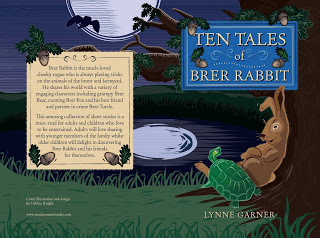 My collection of Brer Rabbit tales, published Jan 2018 I selected five I felt may have the best chance of fulfilling my goal. One of the five I picked was almost published, but fell at the last hurdle (sadly it often happens). Knowing the book market is always changing and is extremely competitive I decided to invest in my writing by sending my chosen stories to be critiqued by a professional.
My collection of Brer Rabbit tales, published Jan 2018 I selected five I felt may have the best chance of fulfilling my goal. One of the five I picked was almost published, but fell at the last hurdle (sadly it often happens). Knowing the book market is always changing and is extremely competitive I decided to invest in my writing by sending my chosen stories to be critiqued by a professional.
I discovered once I'd pressed that send button it felt like I was back at Uni and I'd submitted my course work. As I waited I began to question myself and my writing. What if I'd lost it? (What ever 'it' is). What if they think none of them have potential? What if ...?
Thankfully, when I received the feedback it wasn't anywhere near as bad as I'd feared. In fact it was quite positive. Unsurprisingly, areas for improvement had been highlighted. So, for the first time in years I've been set homework!
I've read and re-read the feedback and I'm now working through each story. As per suggestions I'm:
Altering the layout slightlyAdding an illustration note here and there, to make things more obviousImproving on the flow of the textCorrecting those little spelling errors I'd missedInserting (in the stories that need it) a second layer to create a more rounded story
Once I've completed this process I plan to resubmit in the hopes I get the thumbs up. If I do then the stories will be sent off to publishers/agents and with fingers crossed I may just get one of them published. If I do it'll prove that it's never to late to go back to school.
Hey, you never know I may even get all five published - us authors always live in hope.
Regards
Lynne
P.S. If you know of a publisher open to un-solisicted submissions or an agent looking for a new author to represent please let me know.
 My collection of Brer Rabbit tales, published Jan 2018 I selected five I felt may have the best chance of fulfilling my goal. One of the five I picked was almost published, but fell at the last hurdle (sadly it often happens). Knowing the book market is always changing and is extremely competitive I decided to invest in my writing by sending my chosen stories to be critiqued by a professional.
My collection of Brer Rabbit tales, published Jan 2018 I selected five I felt may have the best chance of fulfilling my goal. One of the five I picked was almost published, but fell at the last hurdle (sadly it often happens). Knowing the book market is always changing and is extremely competitive I decided to invest in my writing by sending my chosen stories to be critiqued by a professional. I discovered once I'd pressed that send button it felt like I was back at Uni and I'd submitted my course work. As I waited I began to question myself and my writing. What if I'd lost it? (What ever 'it' is). What if they think none of them have potential? What if ...?
Thankfully, when I received the feedback it wasn't anywhere near as bad as I'd feared. In fact it was quite positive. Unsurprisingly, areas for improvement had been highlighted. So, for the first time in years I've been set homework!
I've read and re-read the feedback and I'm now working through each story. As per suggestions I'm:
Altering the layout slightlyAdding an illustration note here and there, to make things more obviousImproving on the flow of the textCorrecting those little spelling errors I'd missedInserting (in the stories that need it) a second layer to create a more rounded story
Once I've completed this process I plan to resubmit in the hopes I get the thumbs up. If I do then the stories will be sent off to publishers/agents and with fingers crossed I may just get one of them published. If I do it'll prove that it's never to late to go back to school.
Hey, you never know I may even get all five published - us authors always live in hope.
Regards
Lynne
P.S. If you know of a publisher open to un-solisicted submissions or an agent looking for a new author to represent please let me know.
Published on February 26, 2018 10:32



